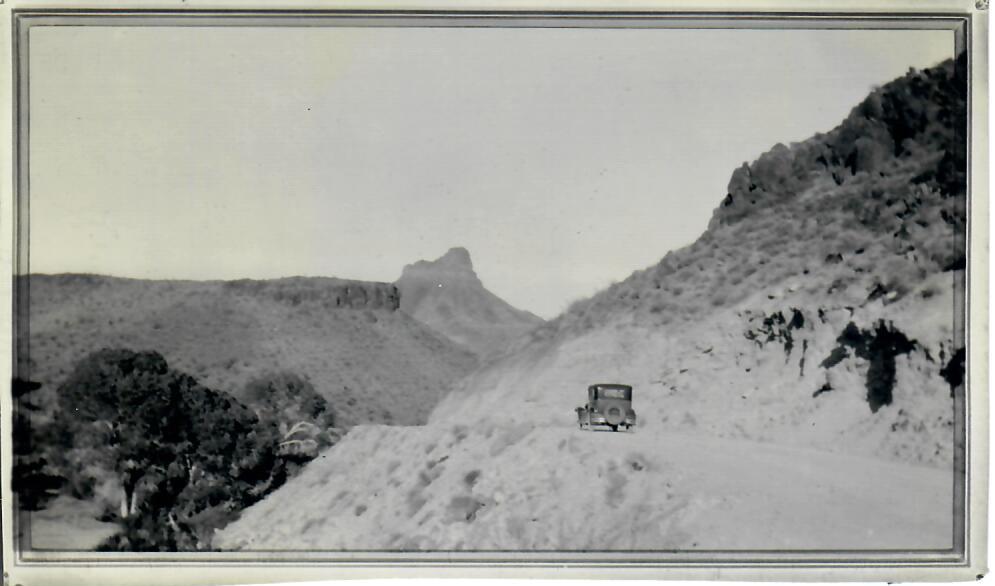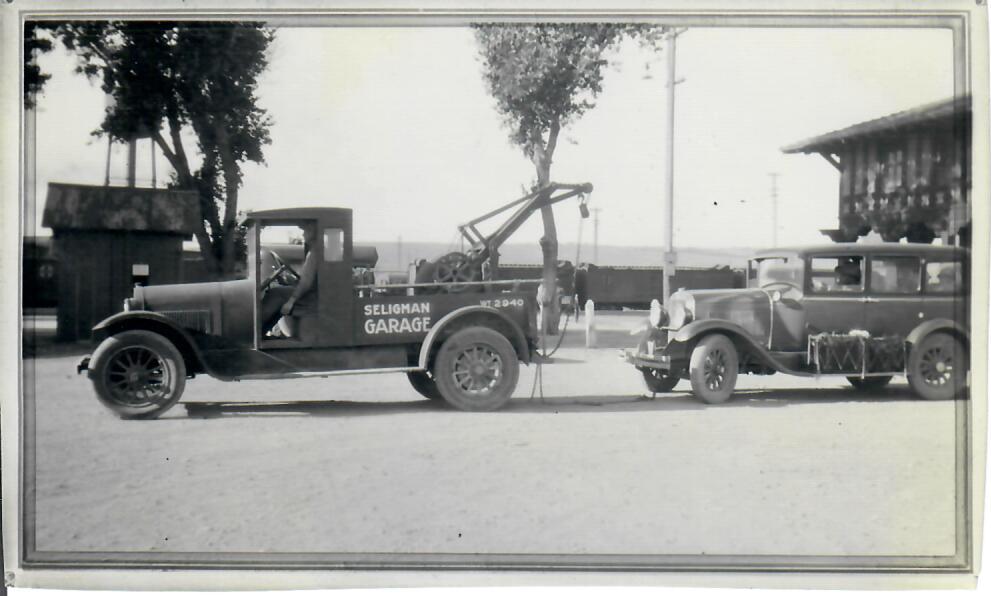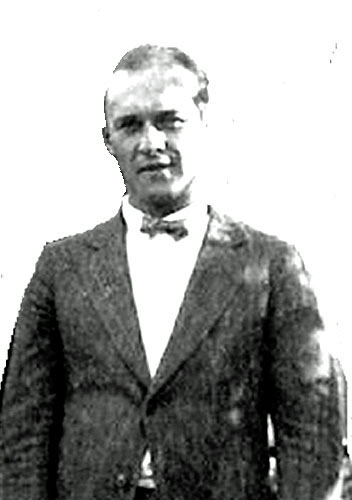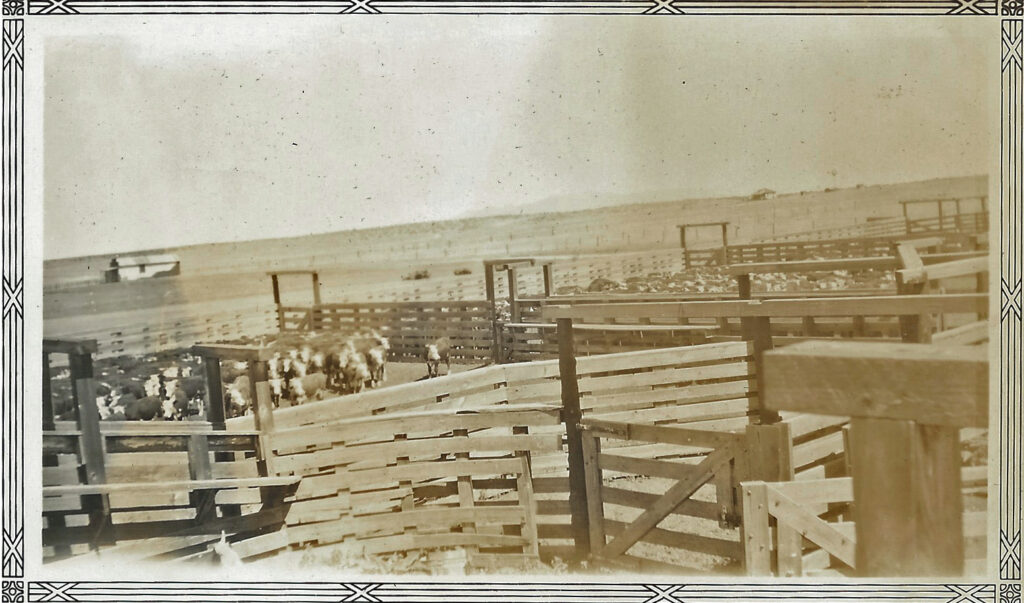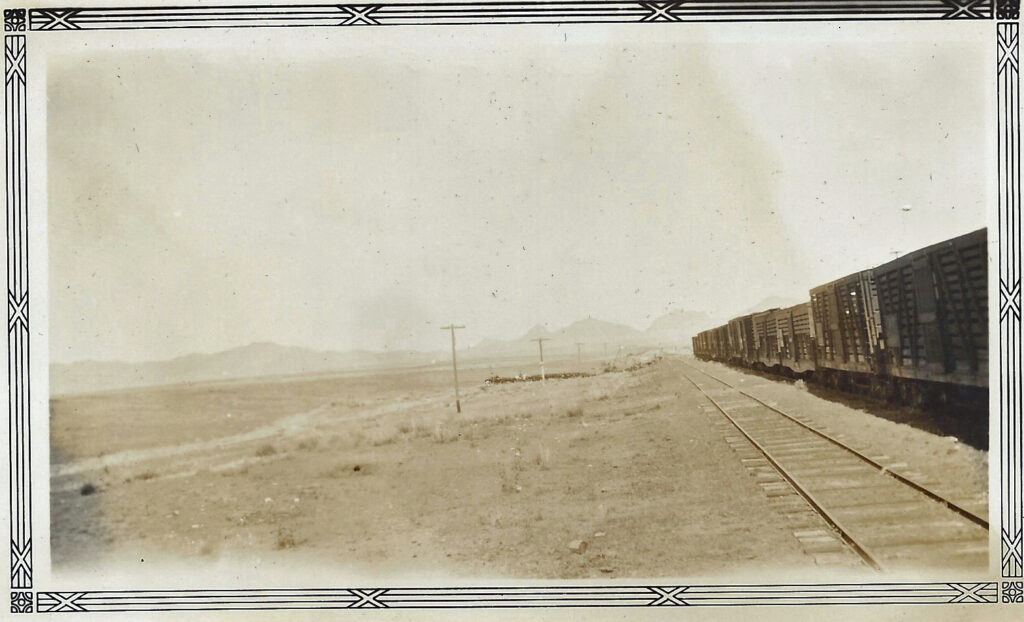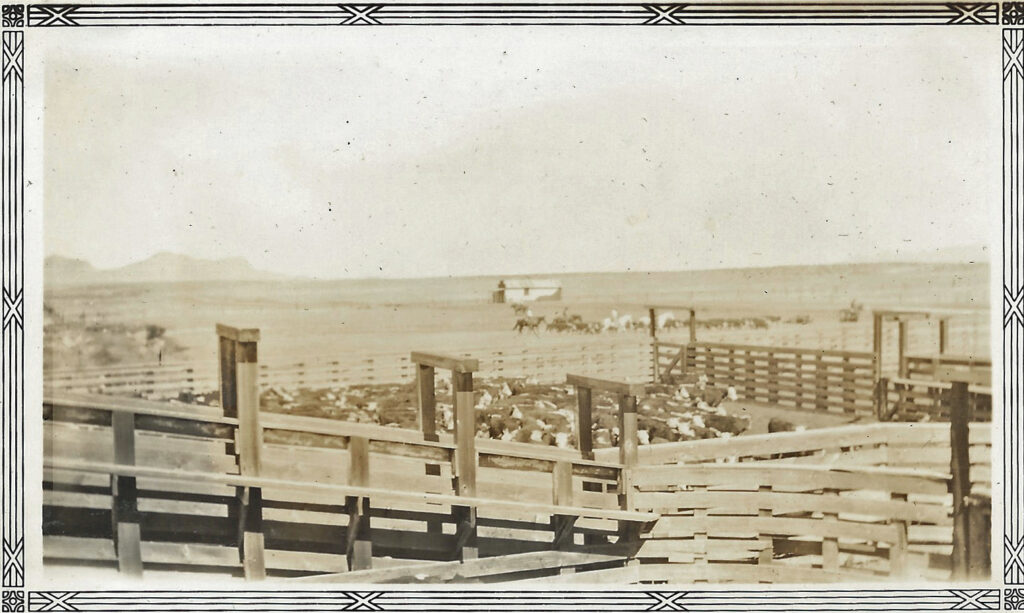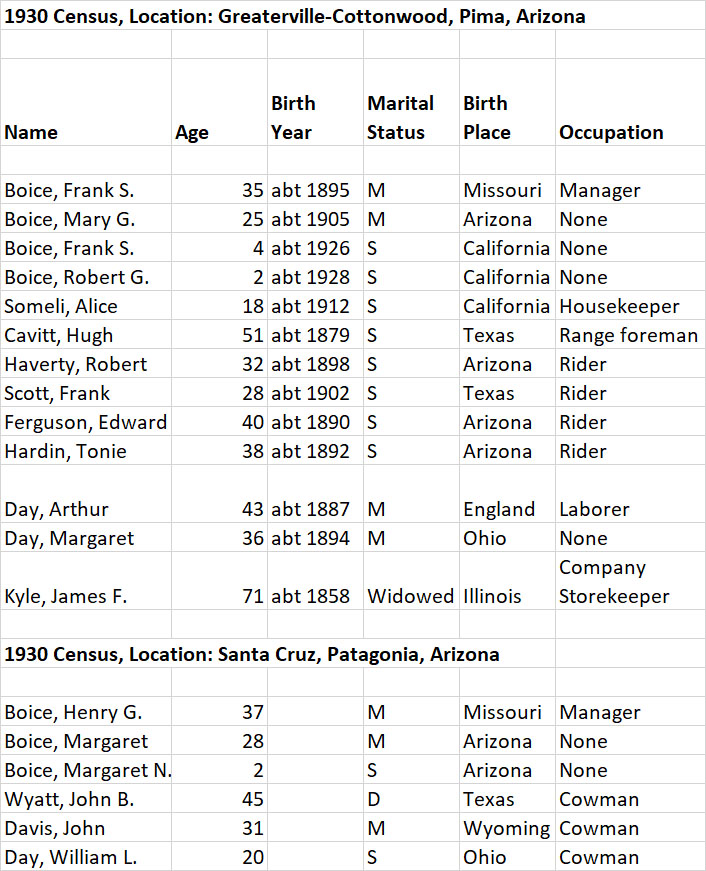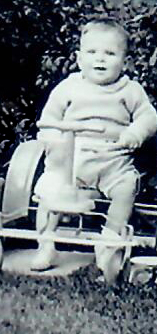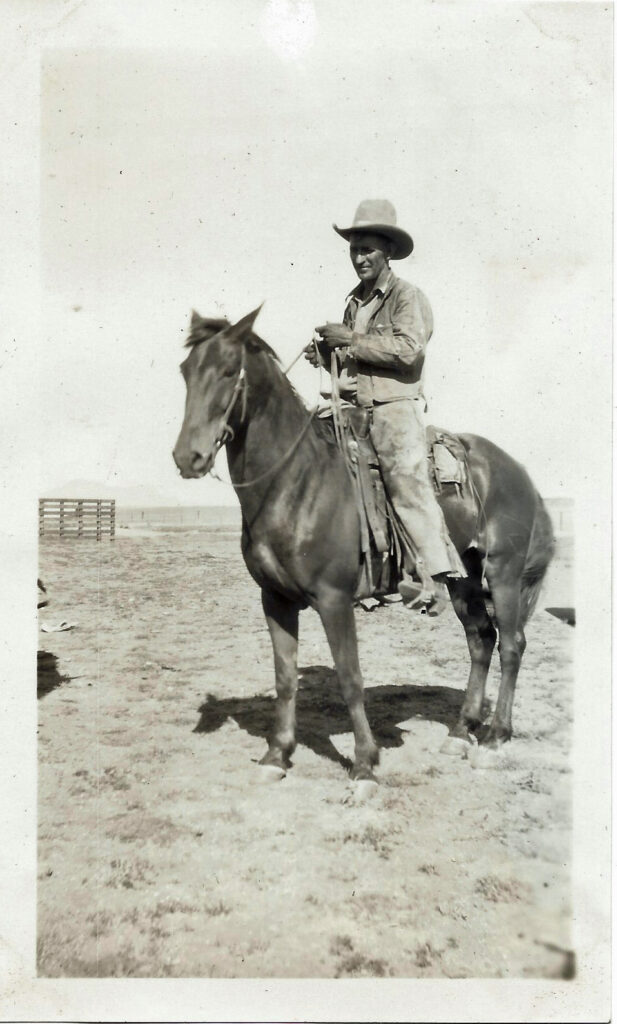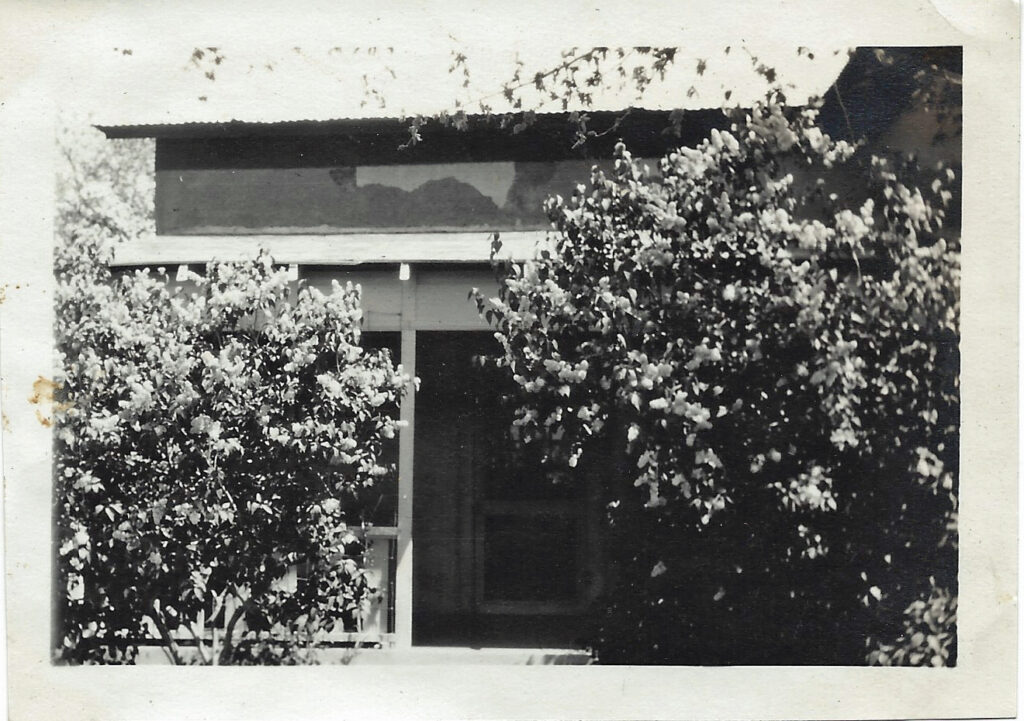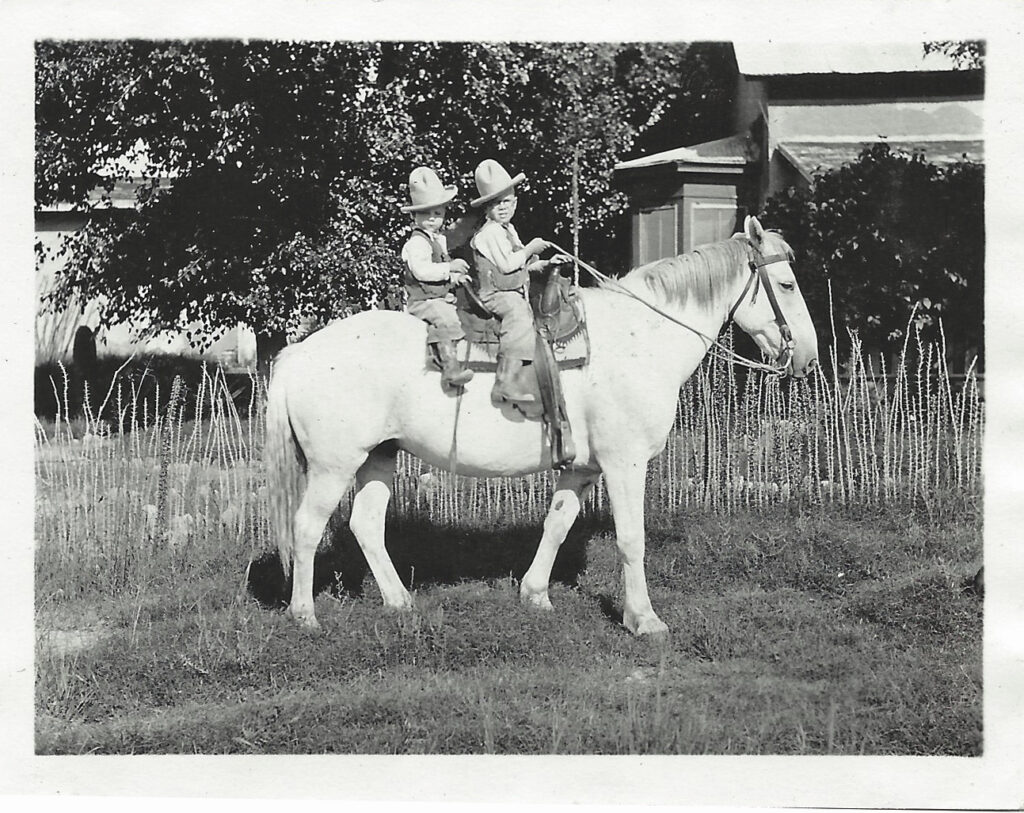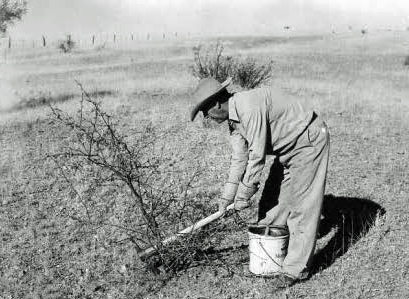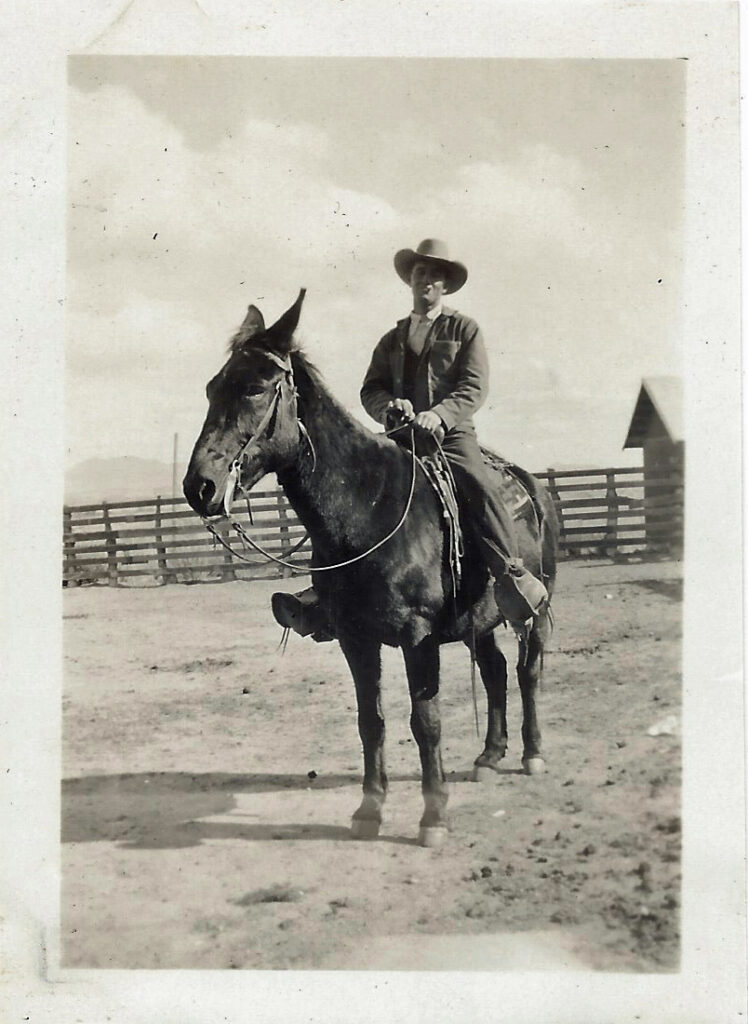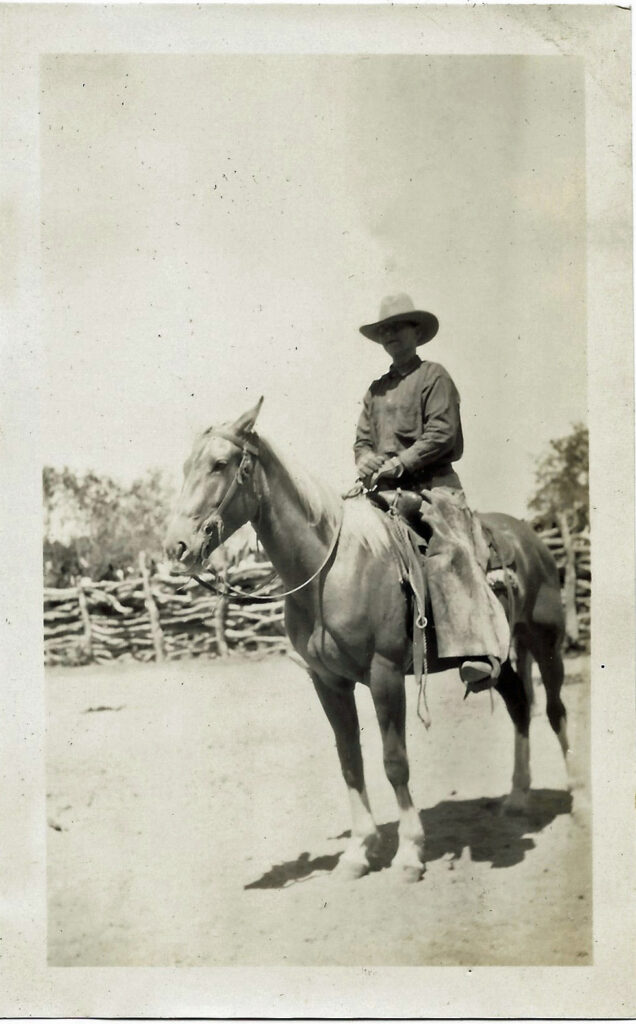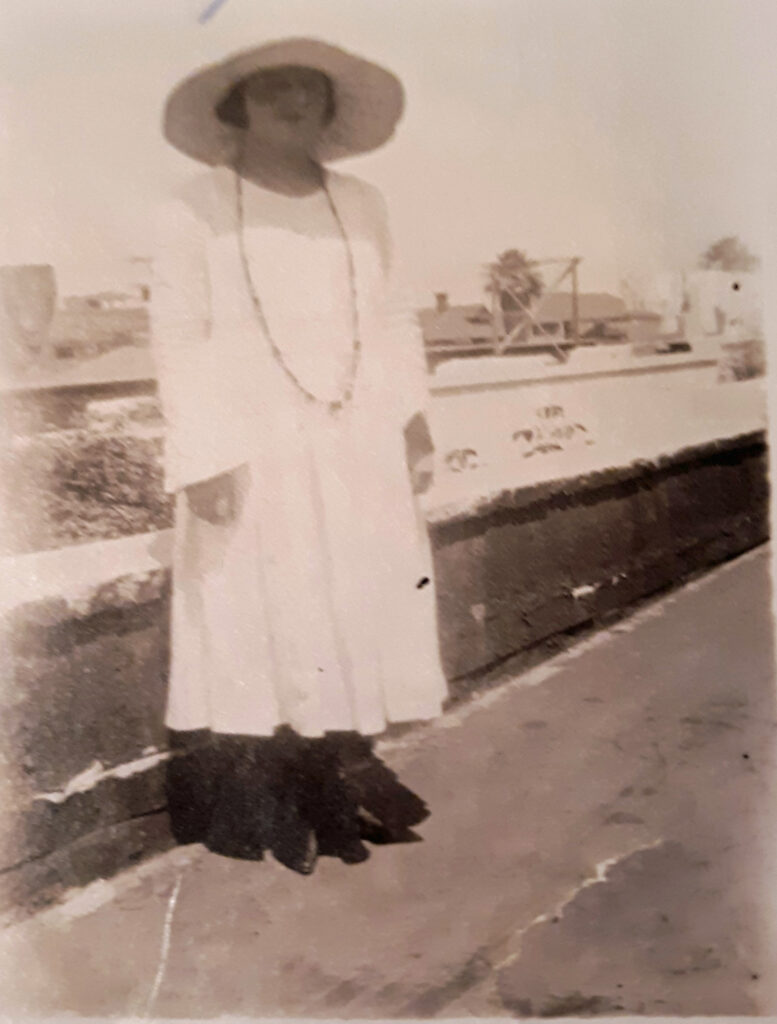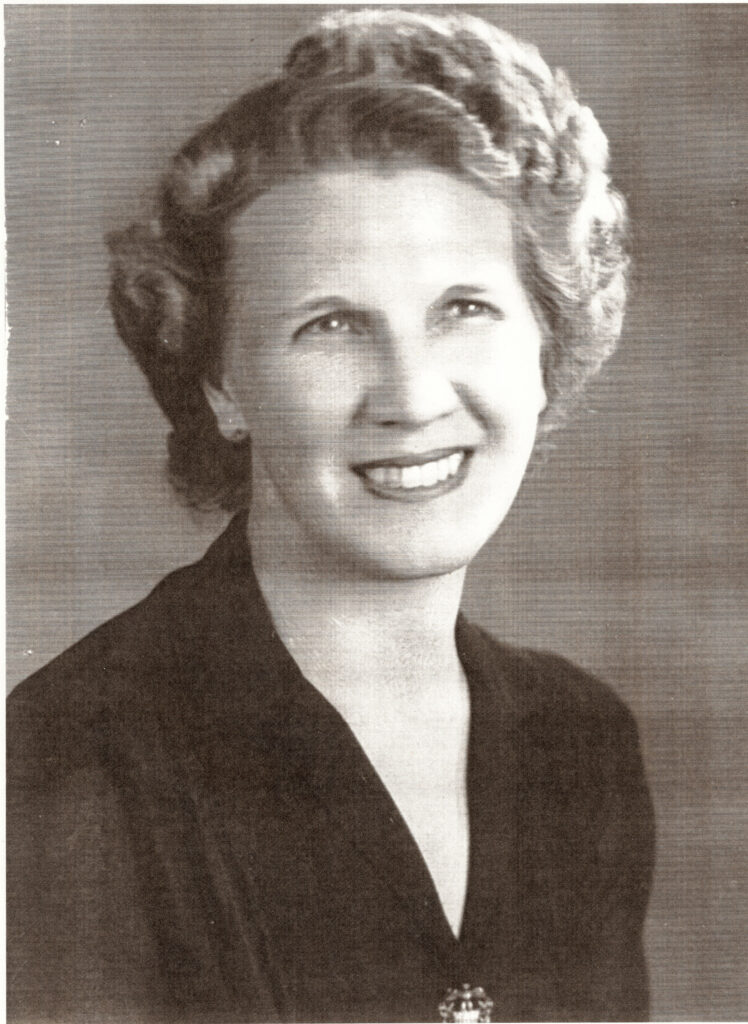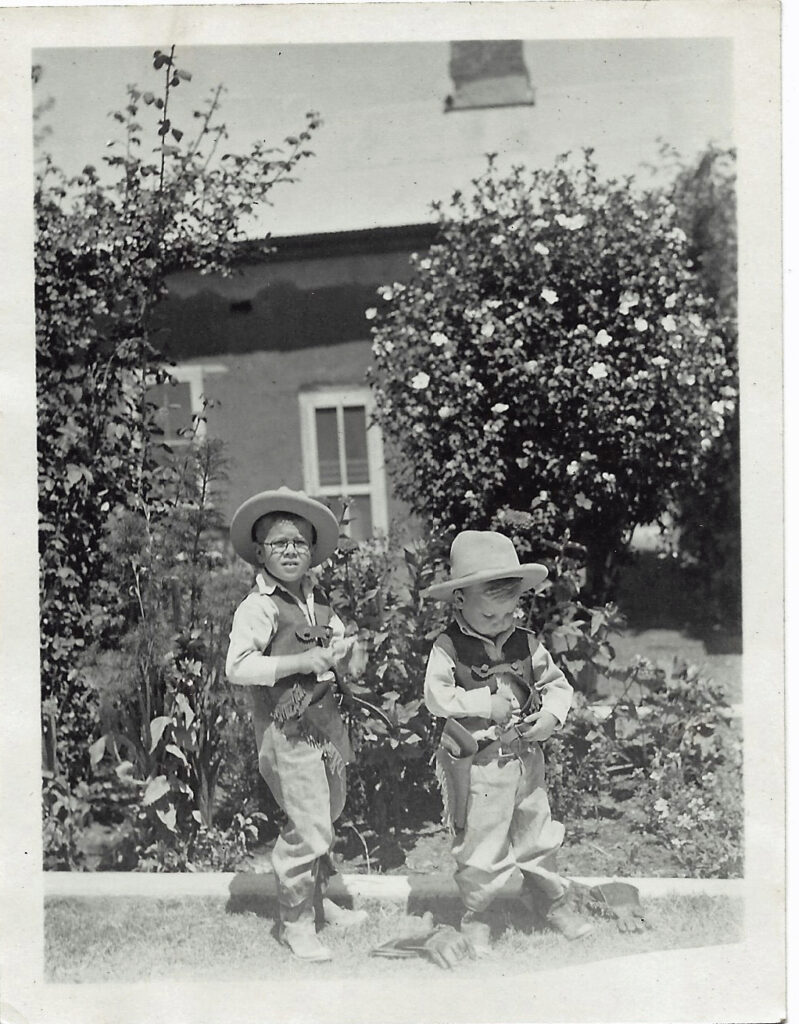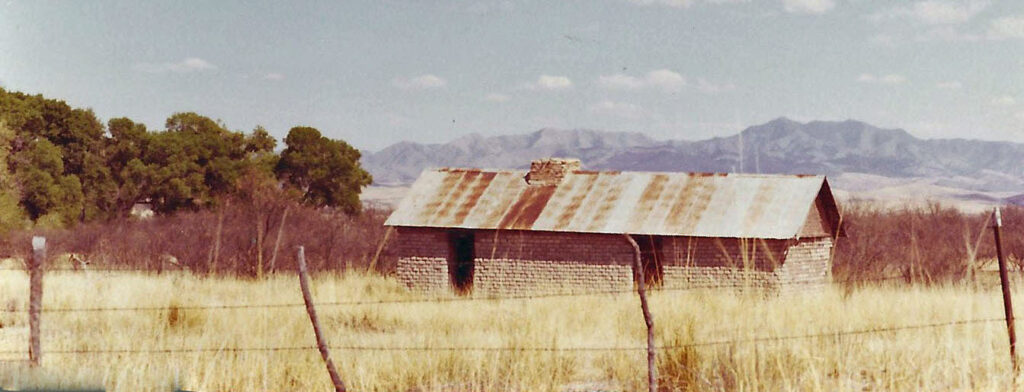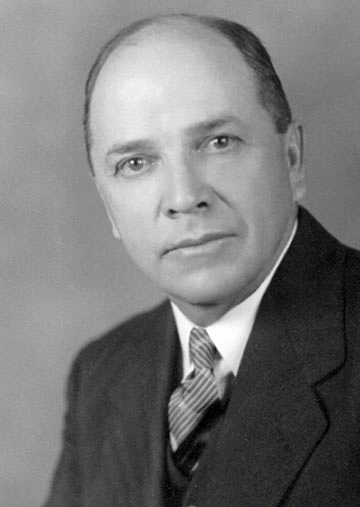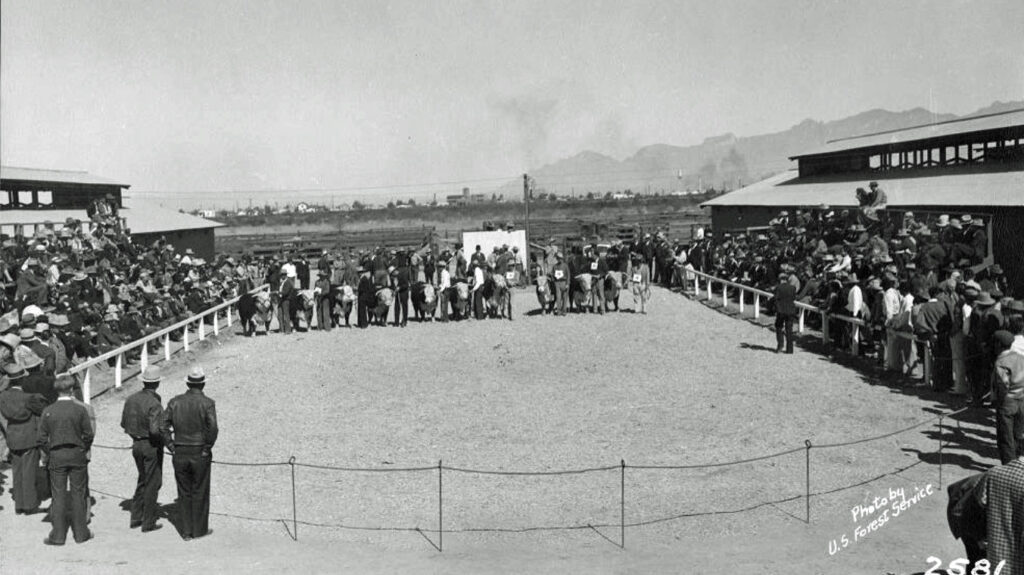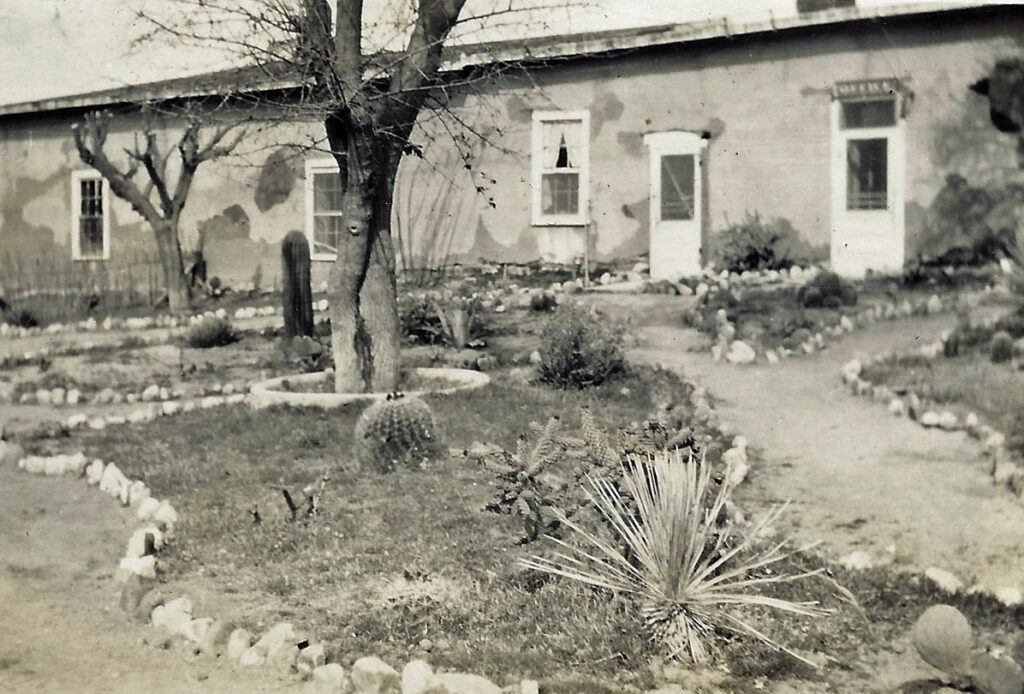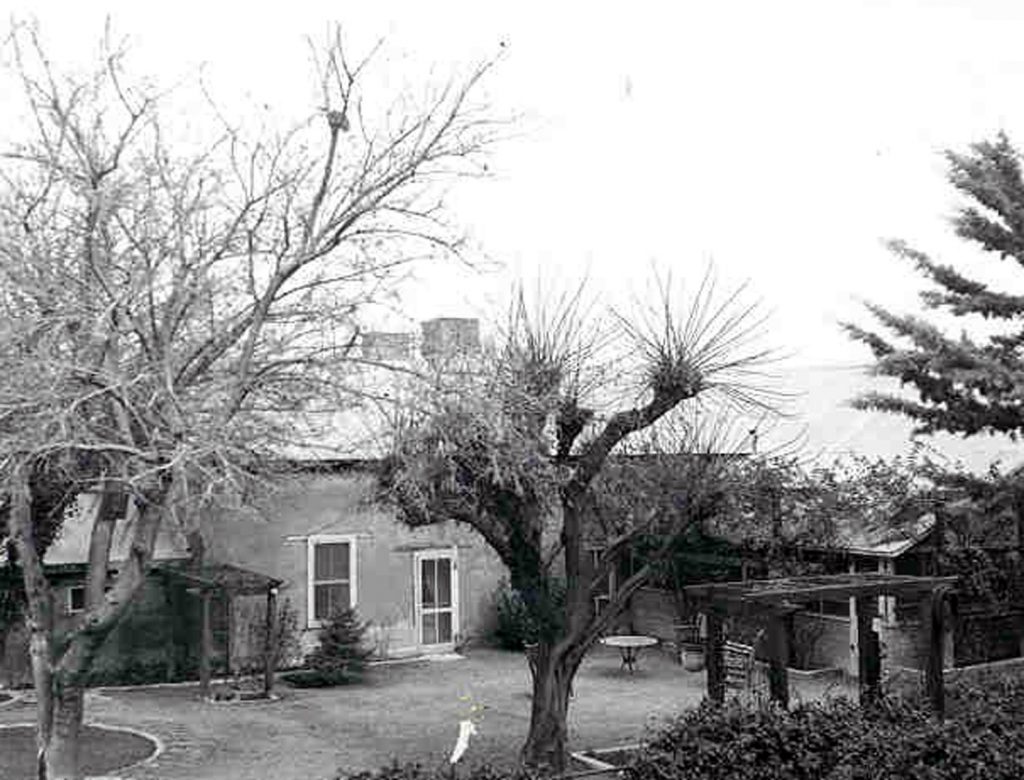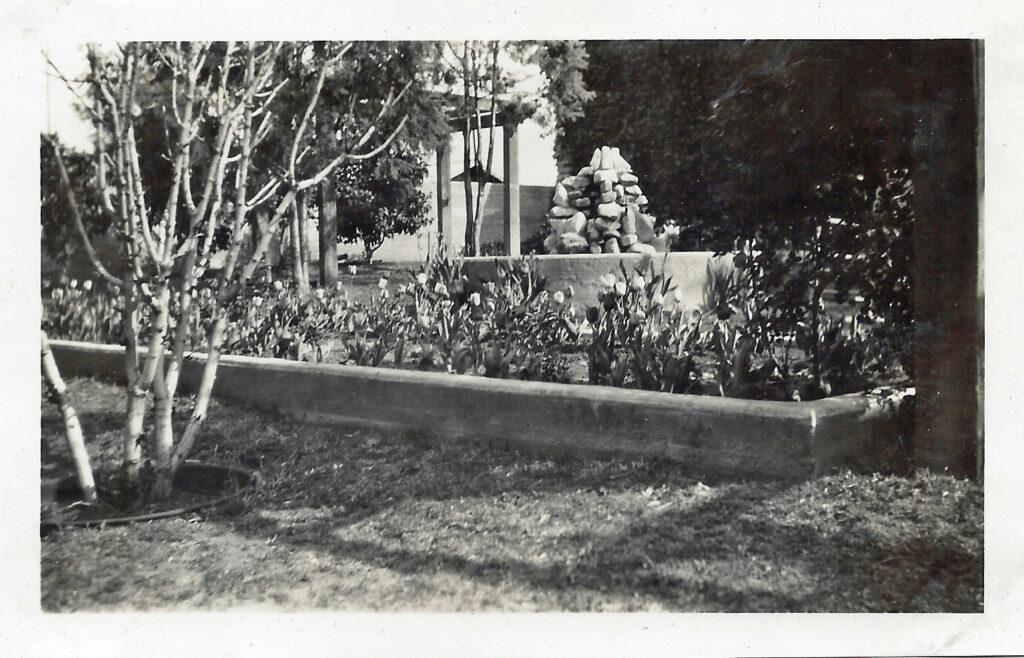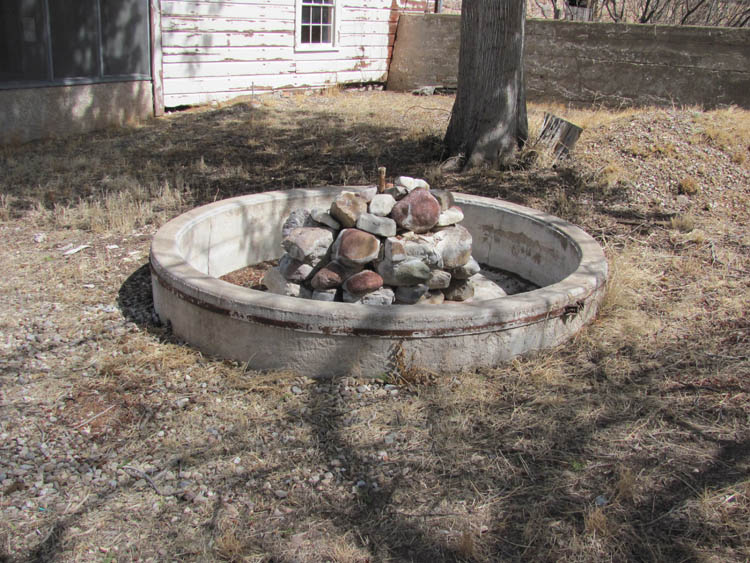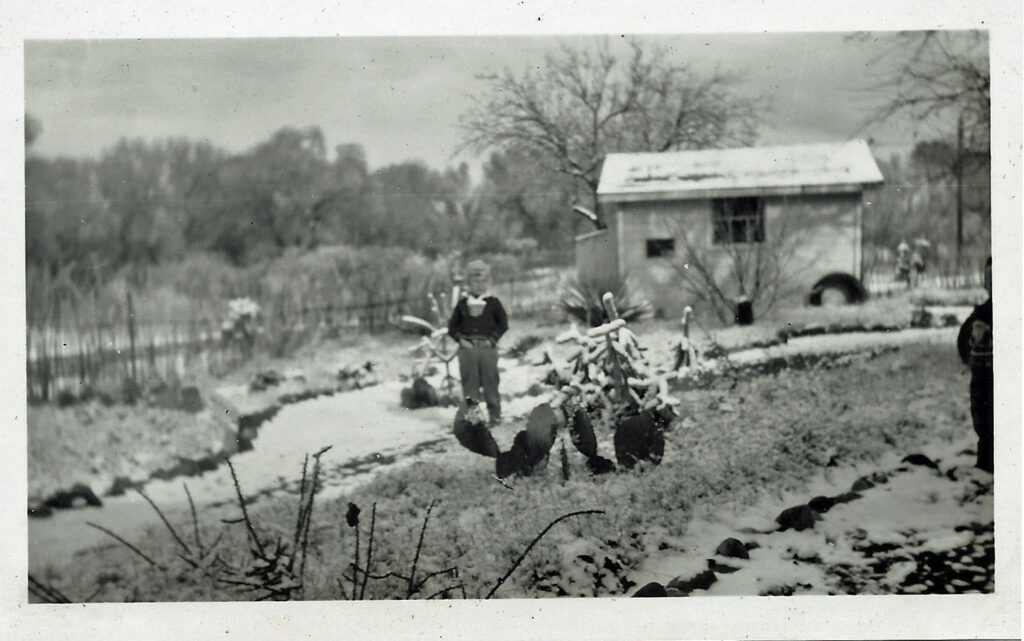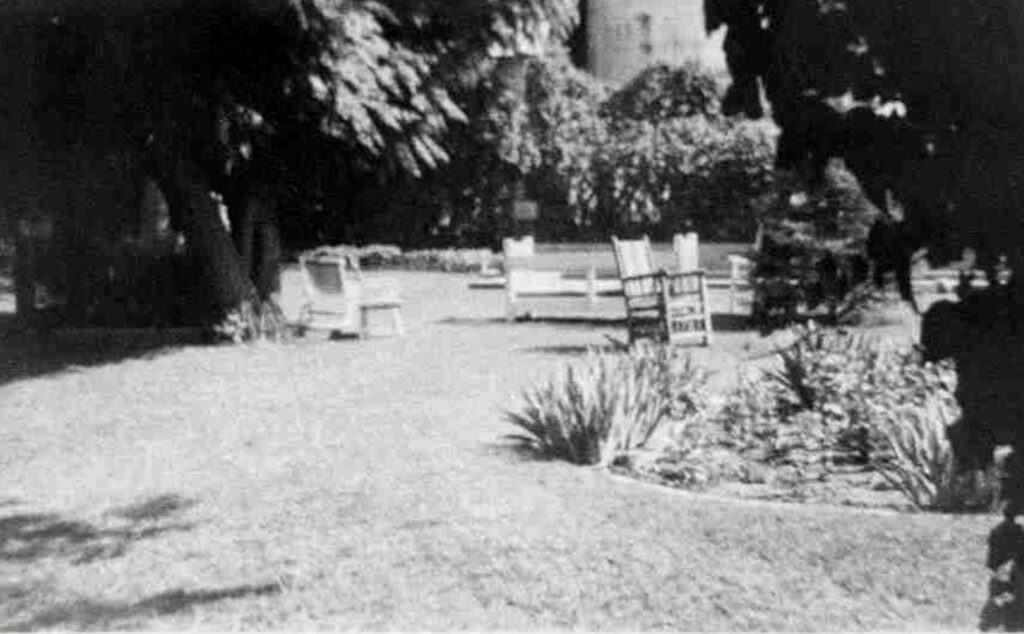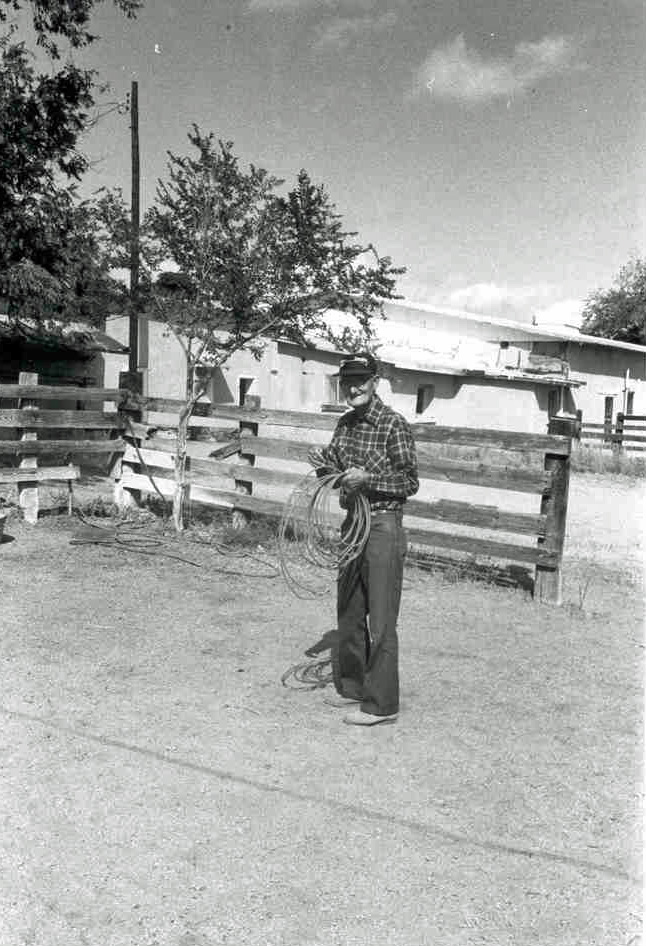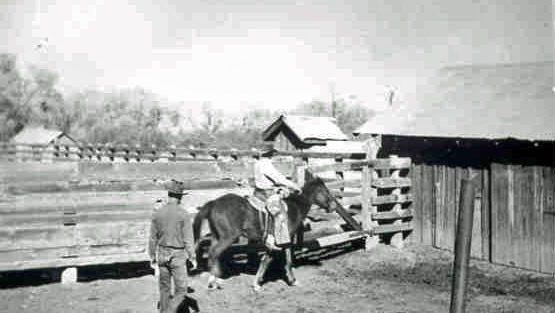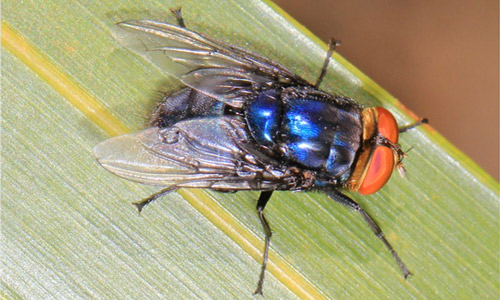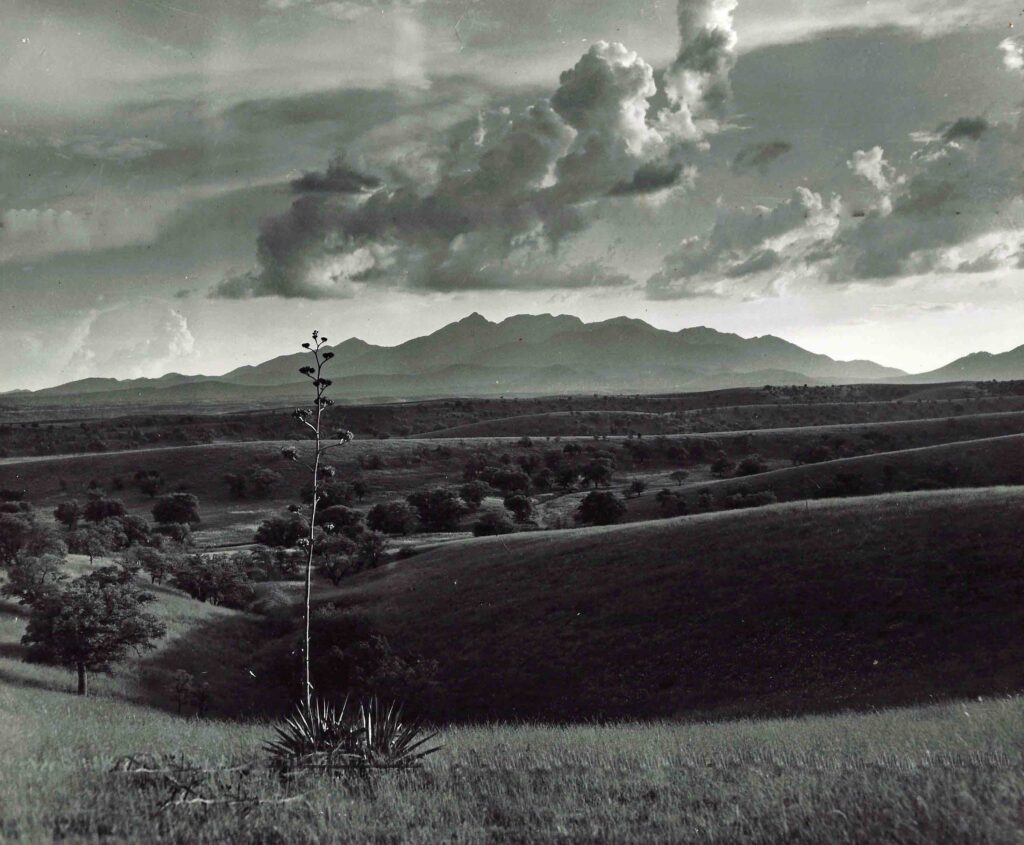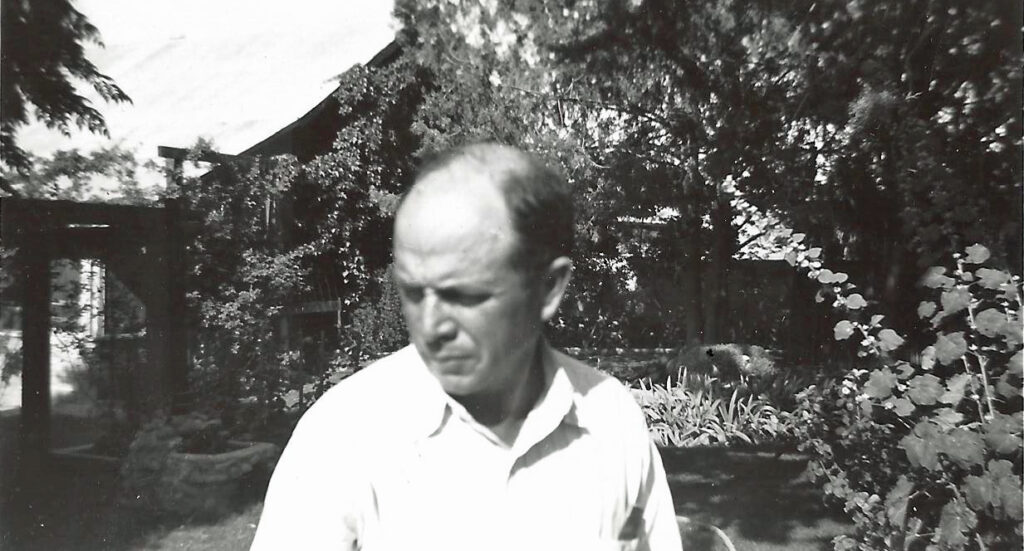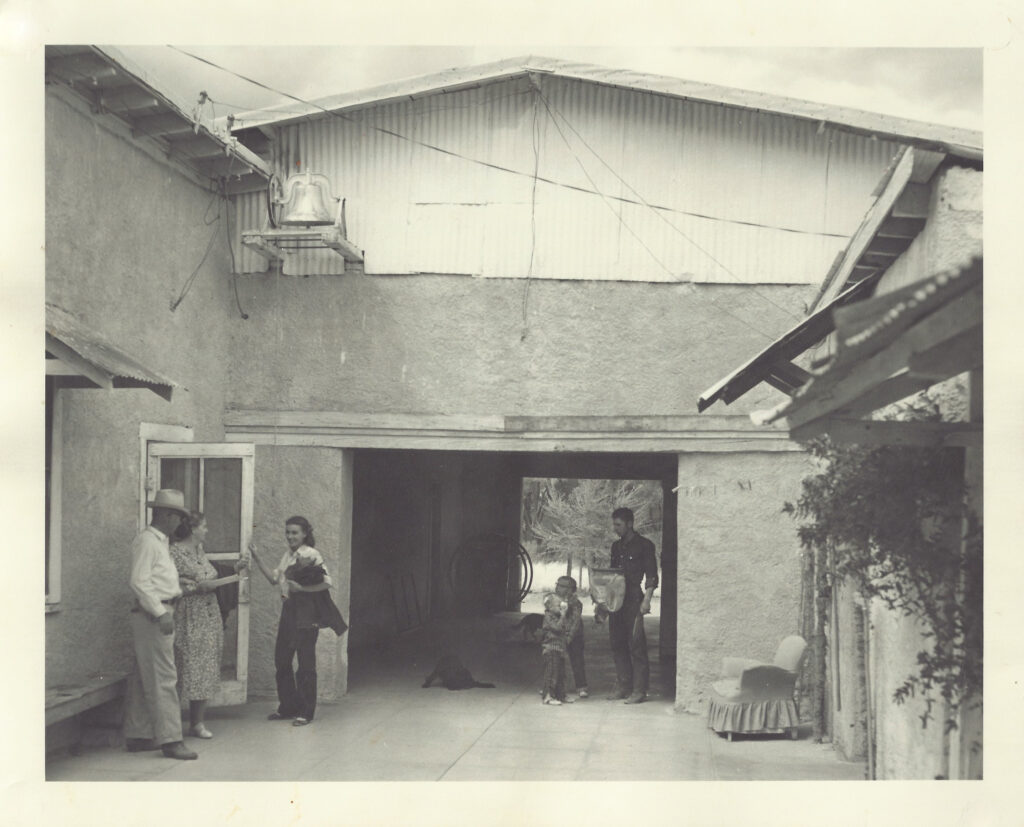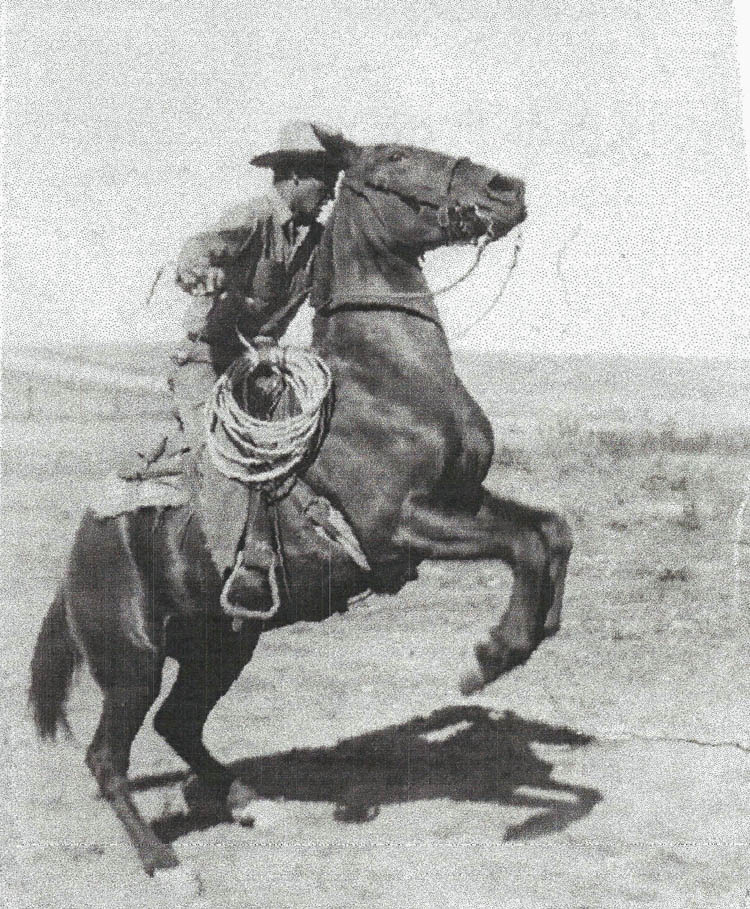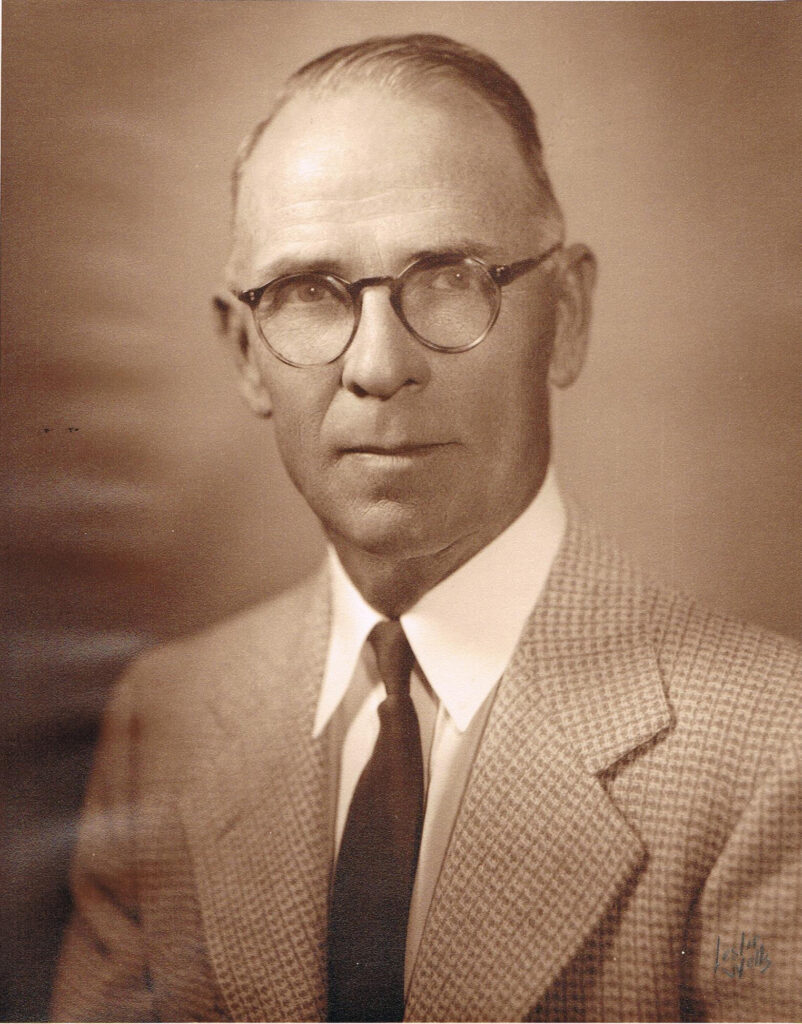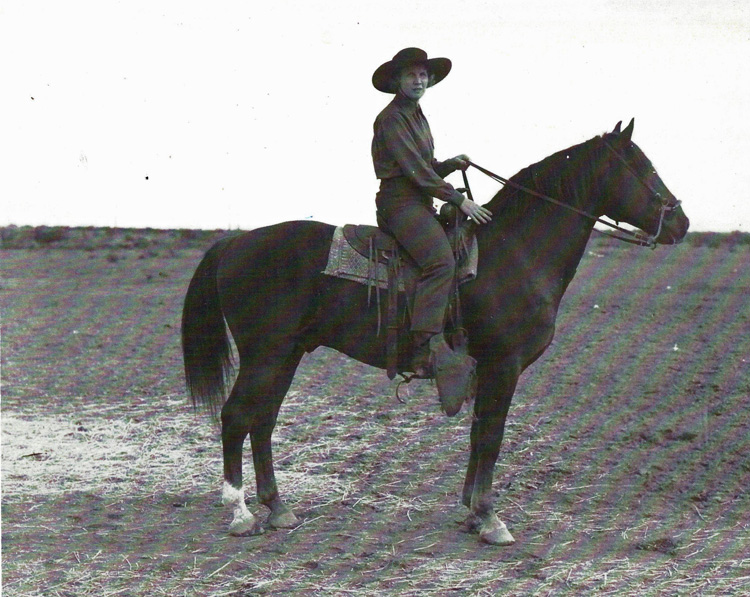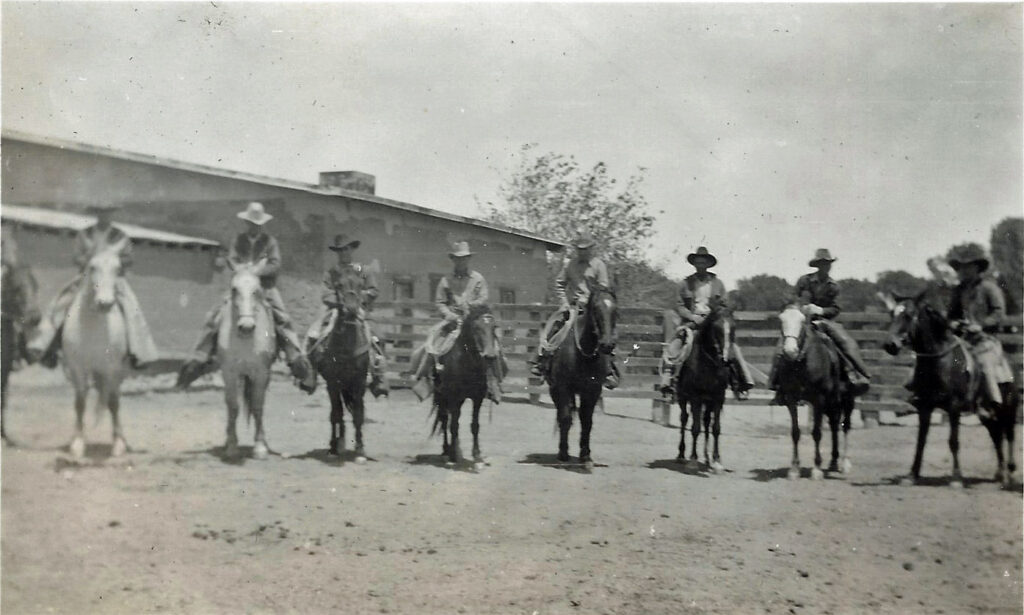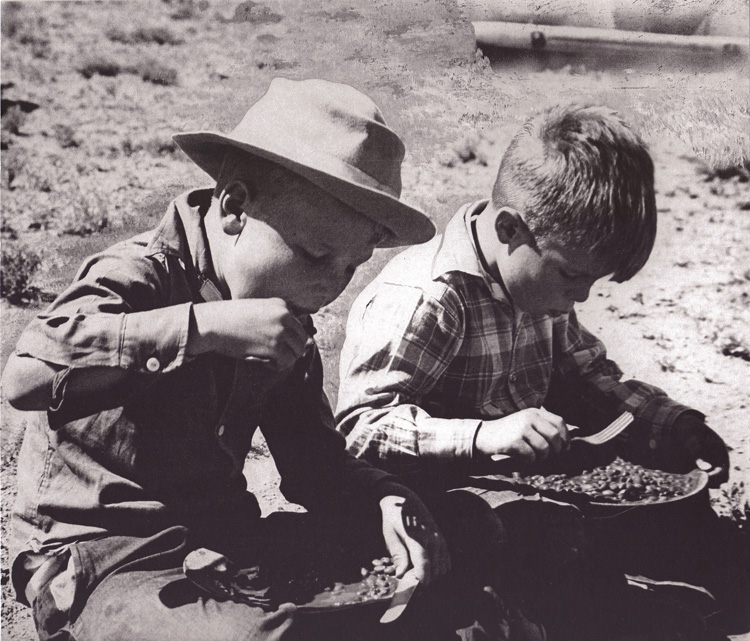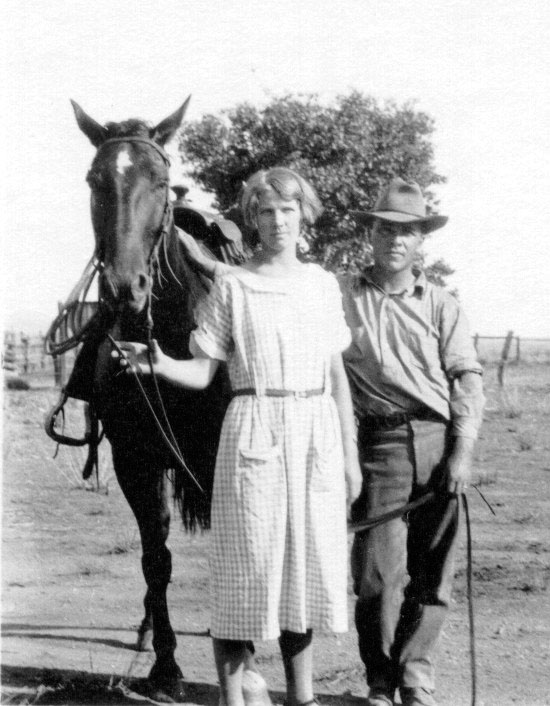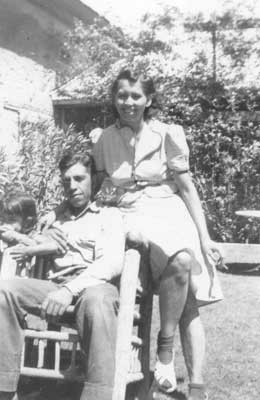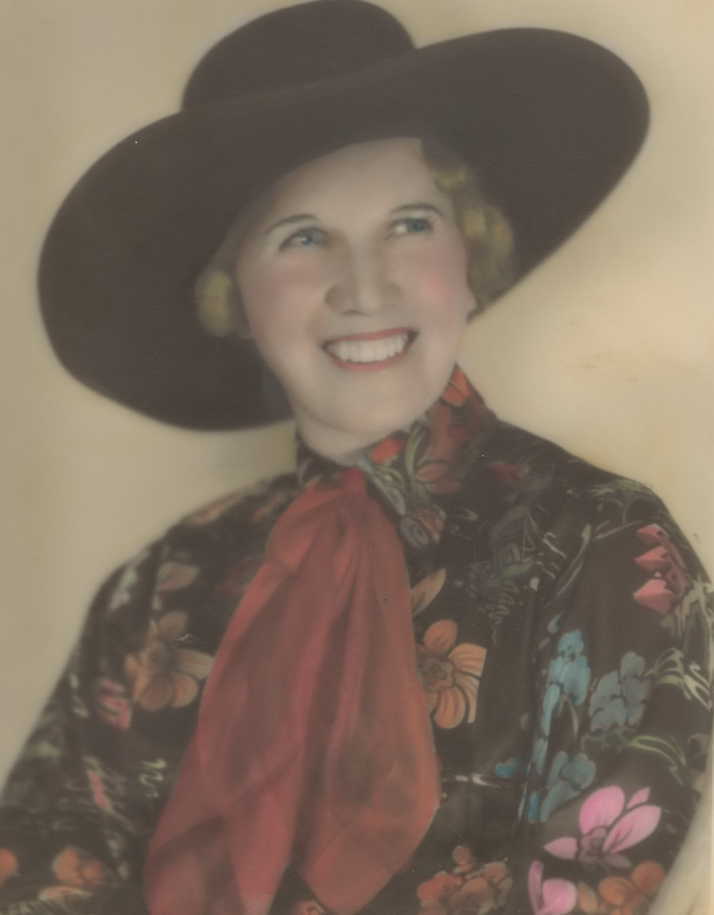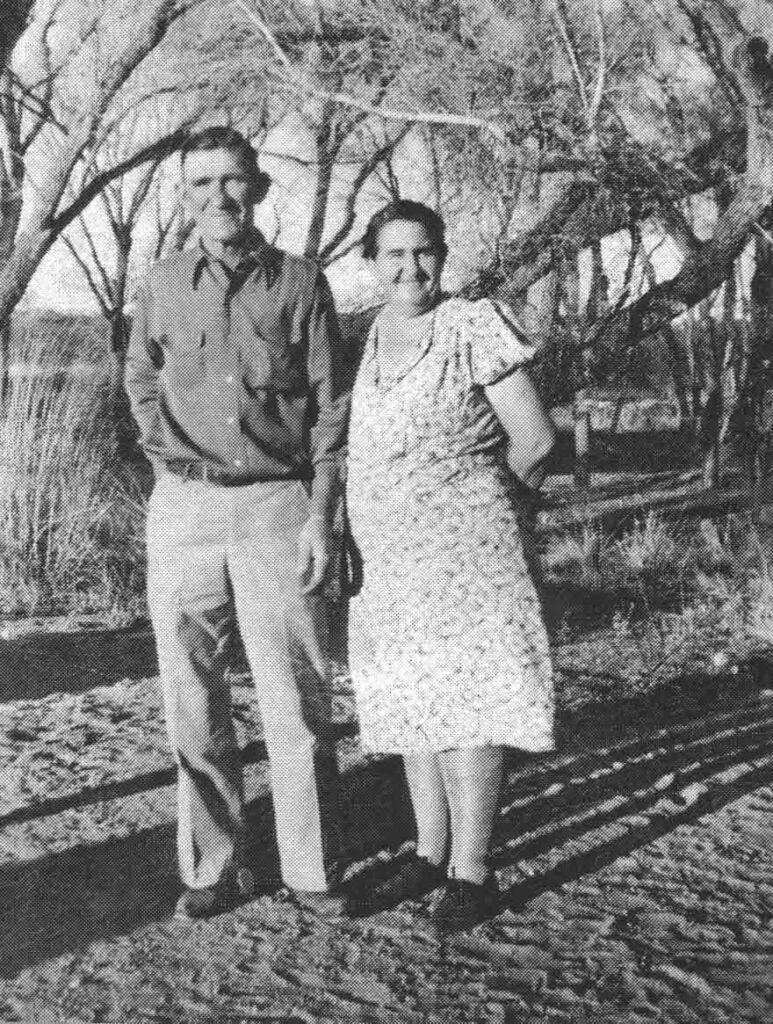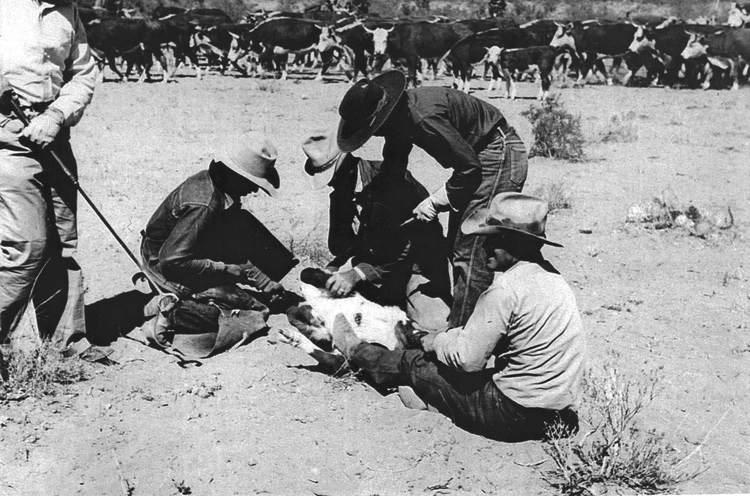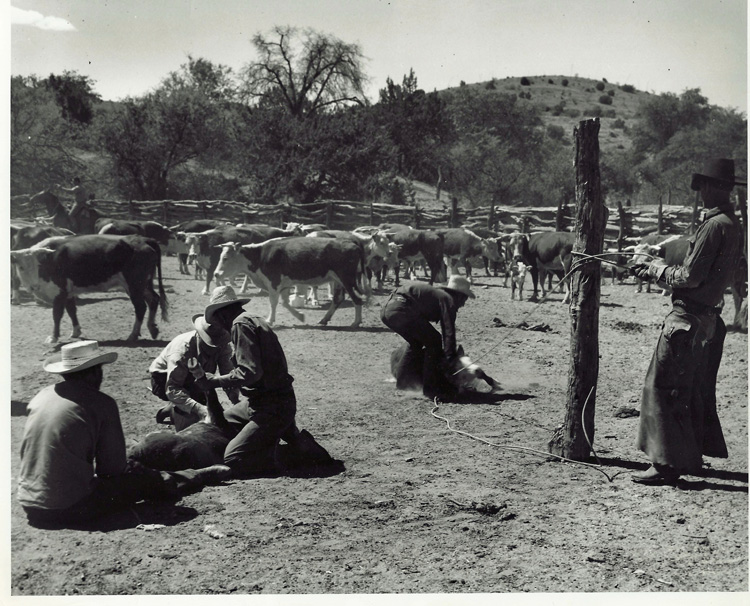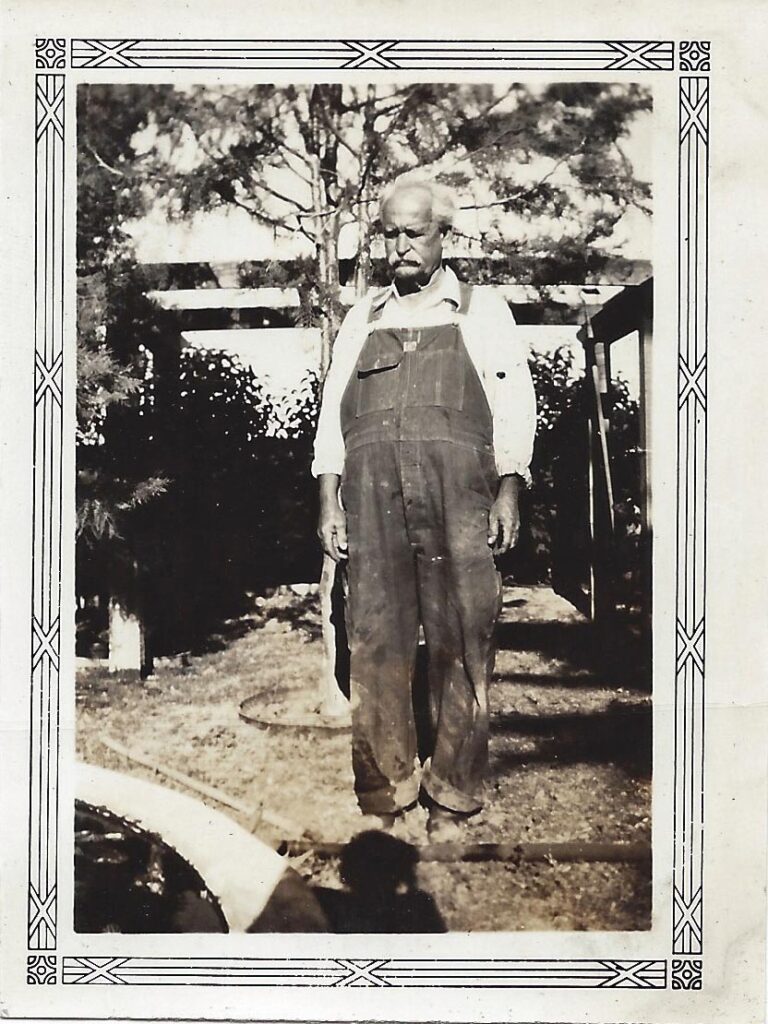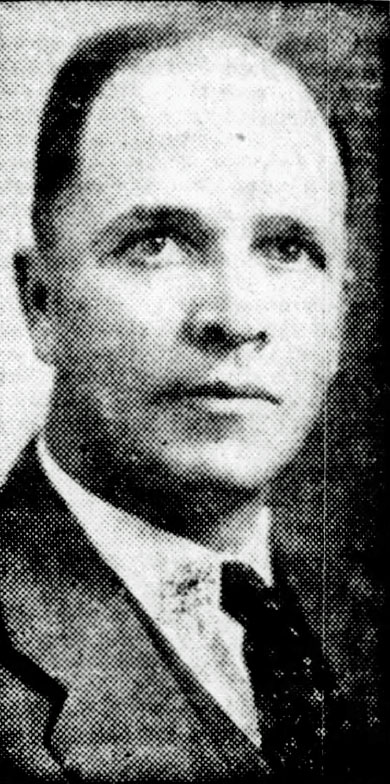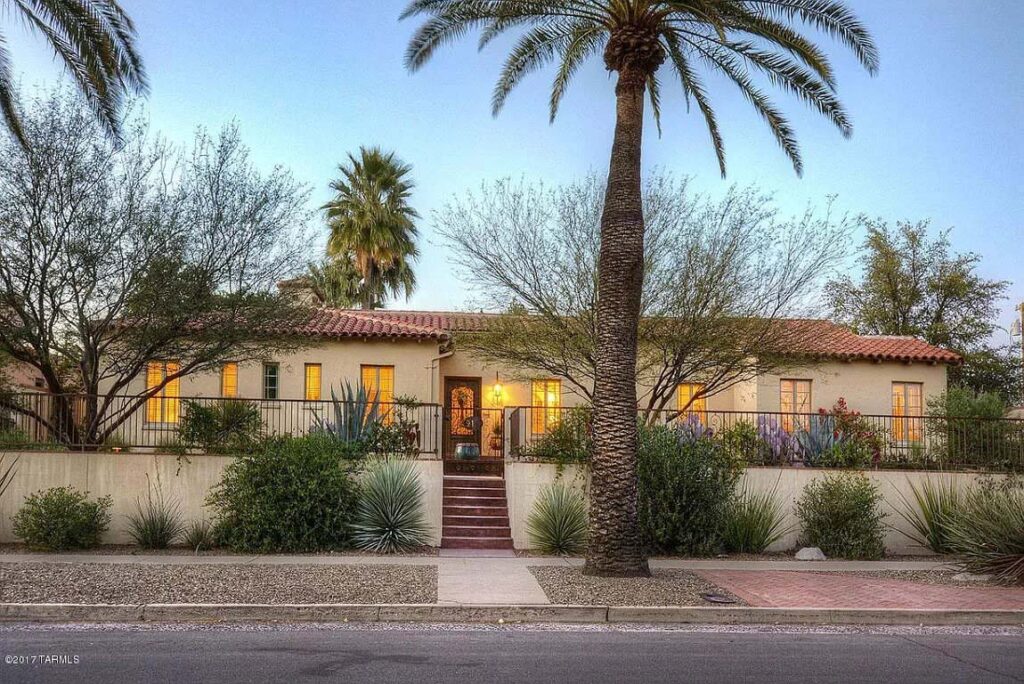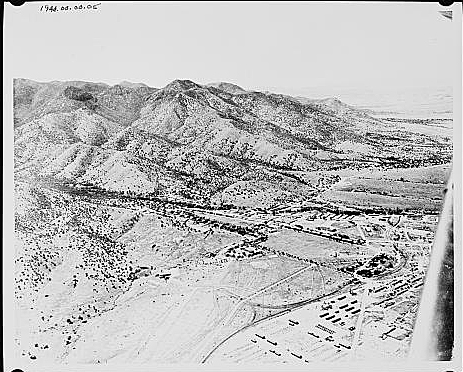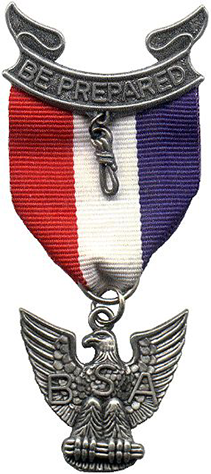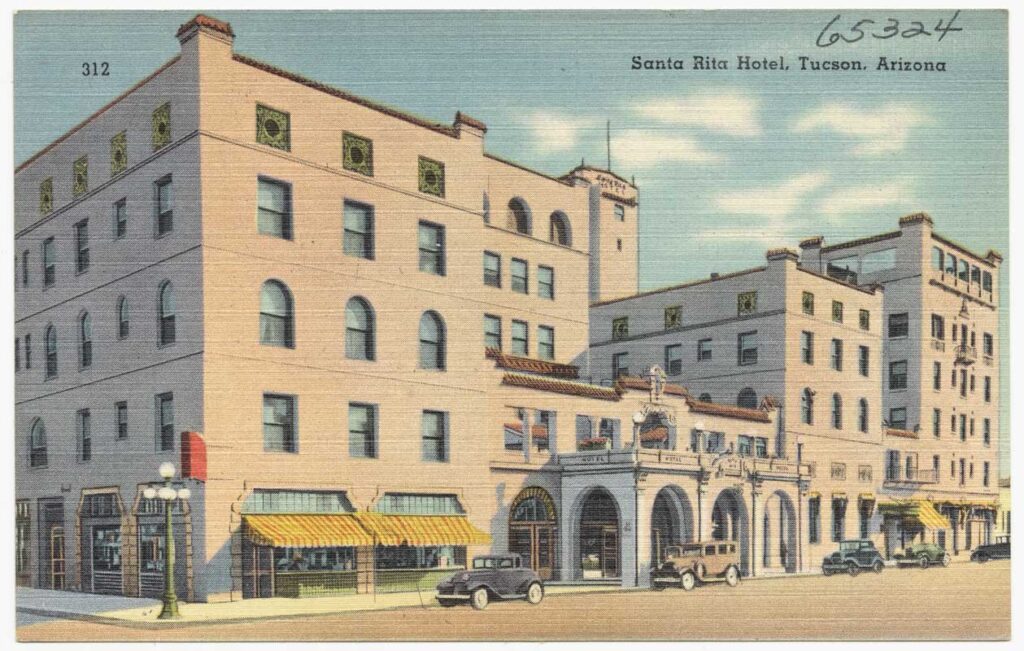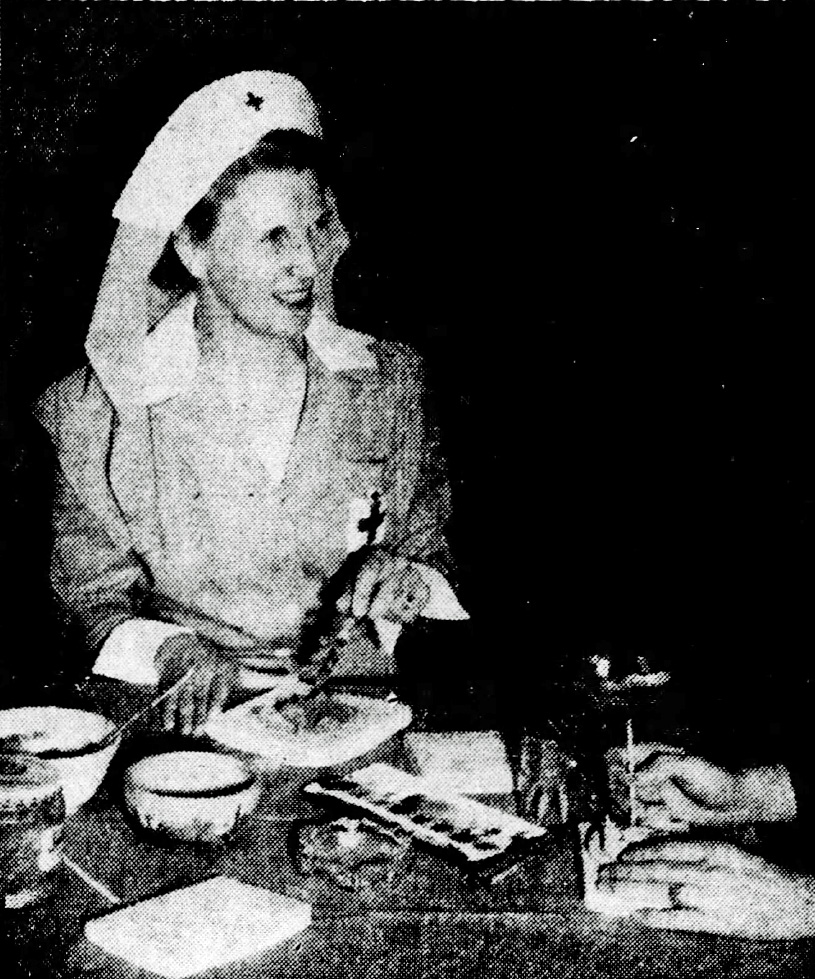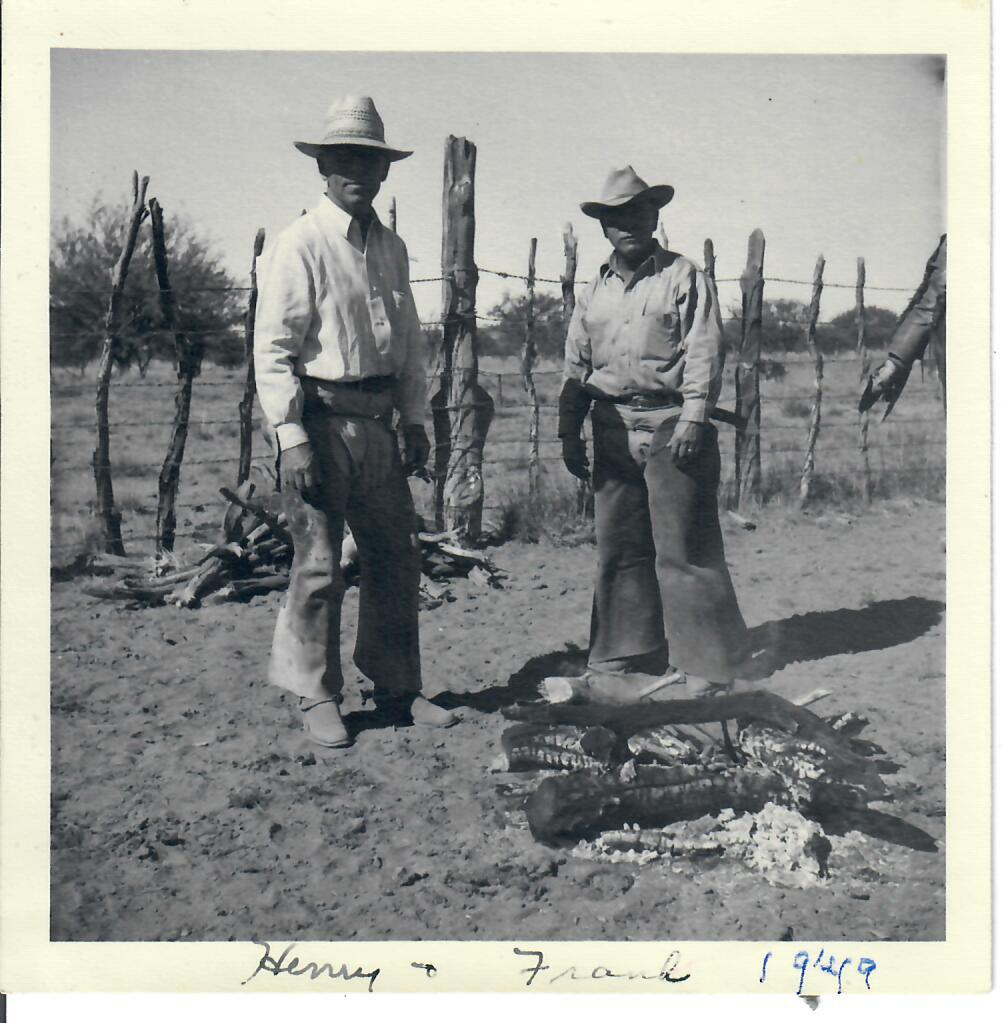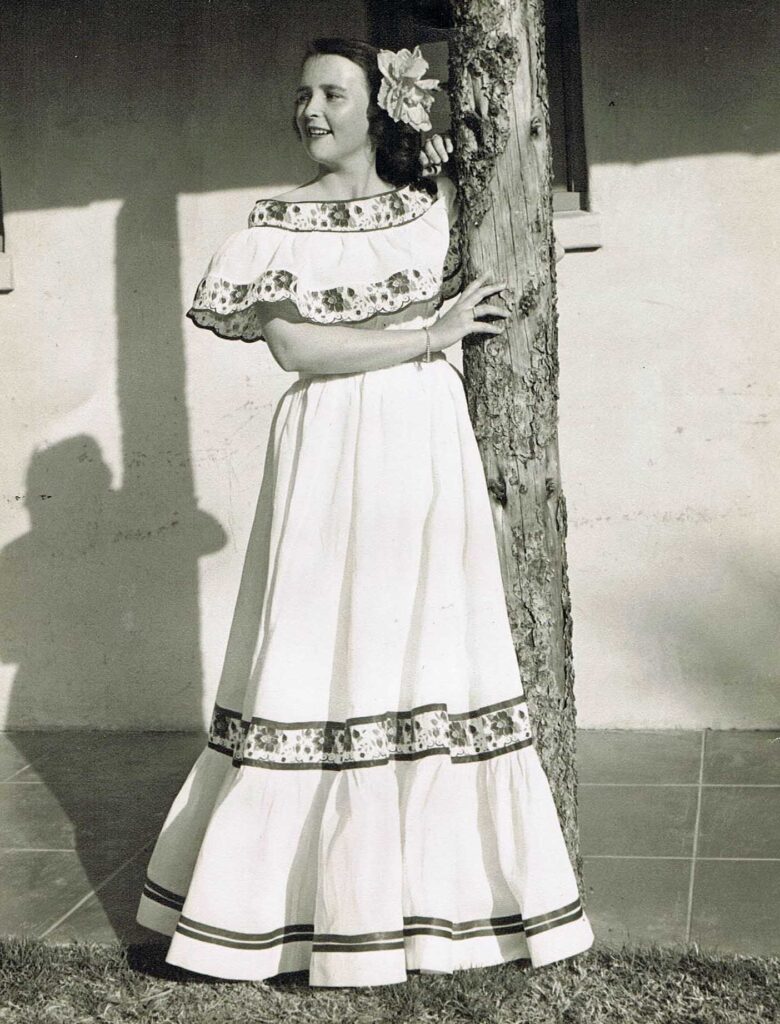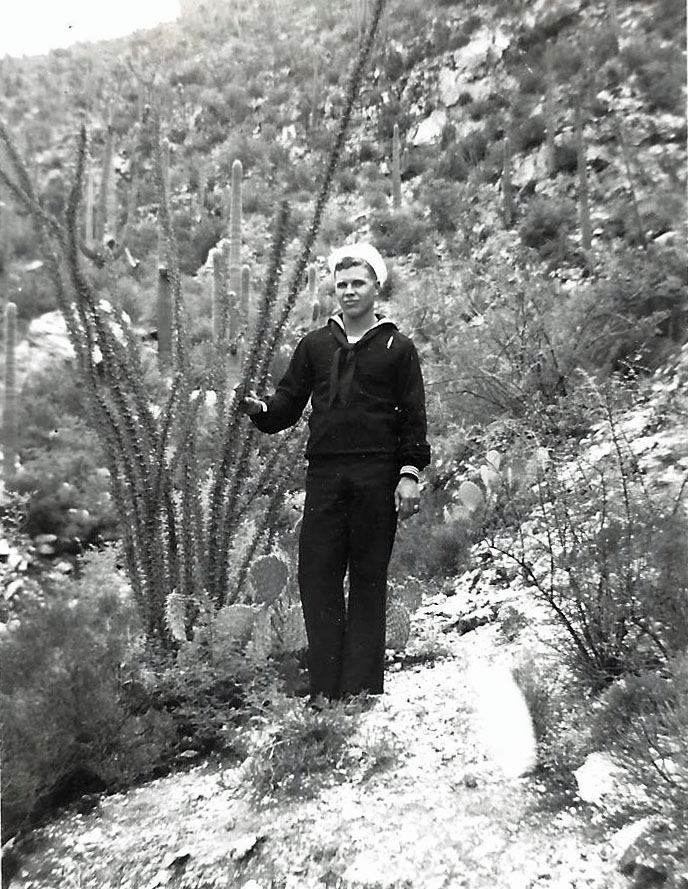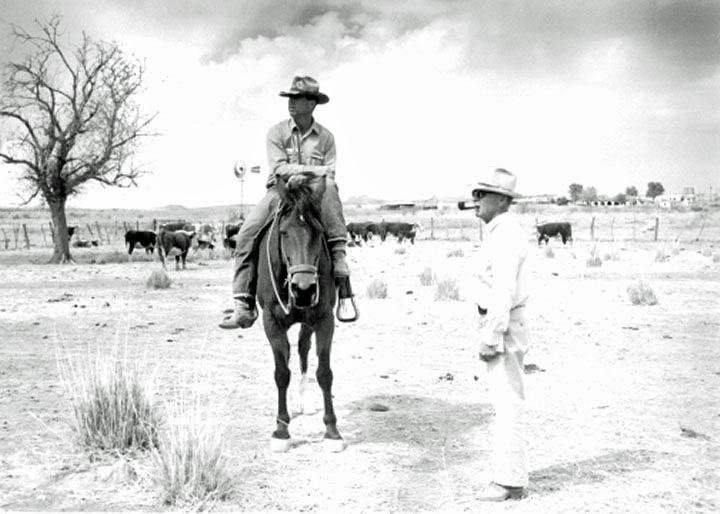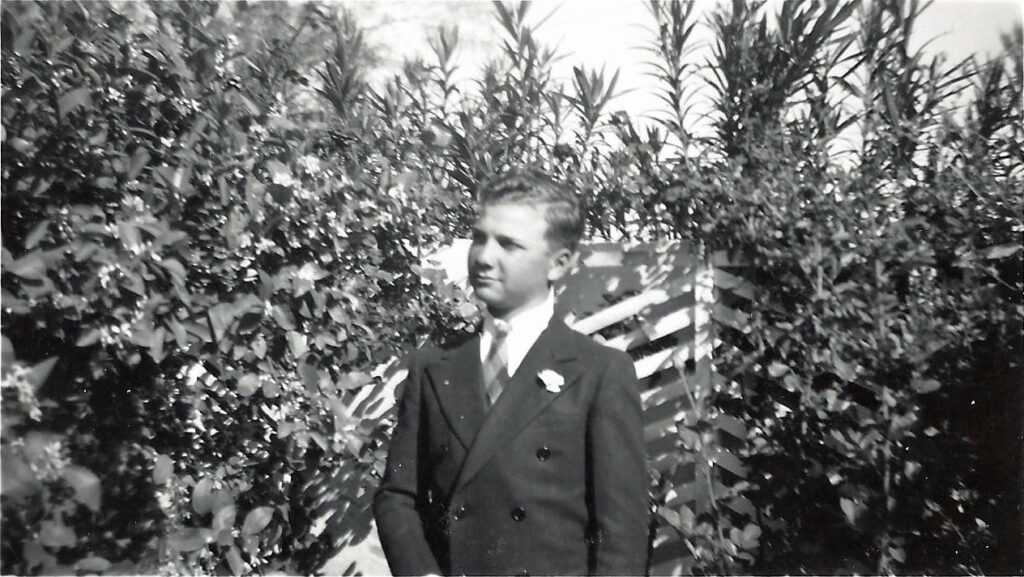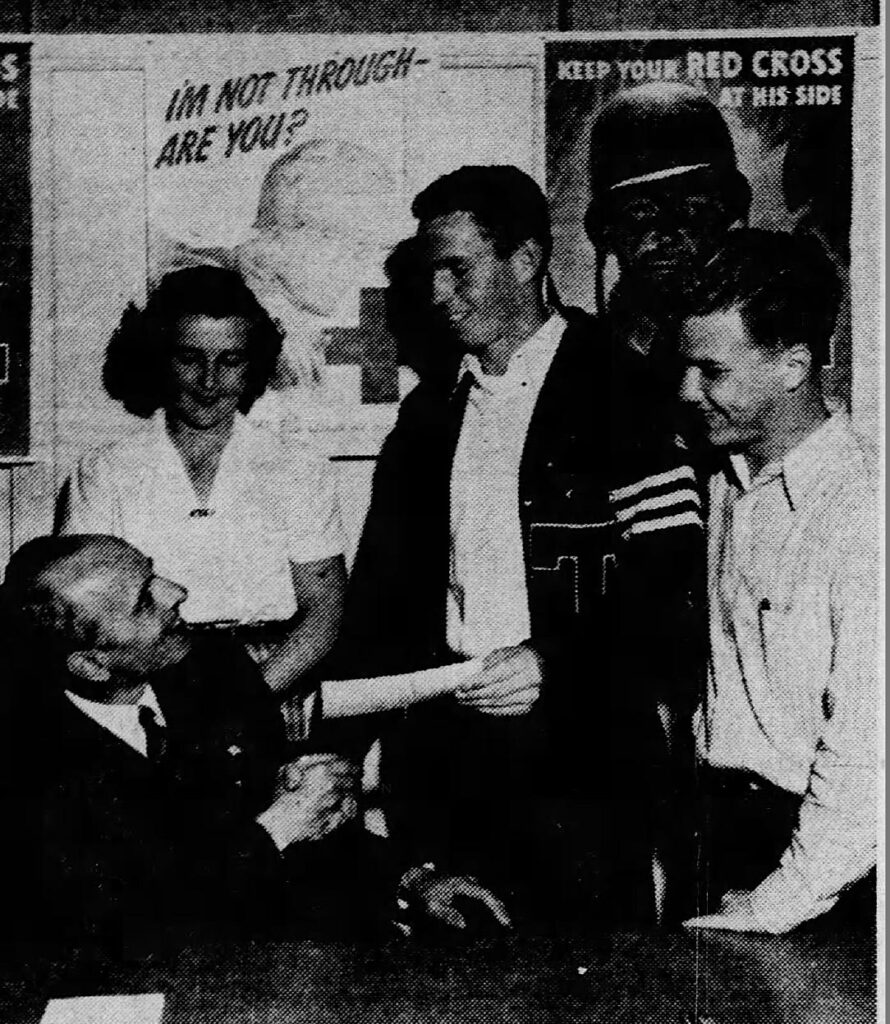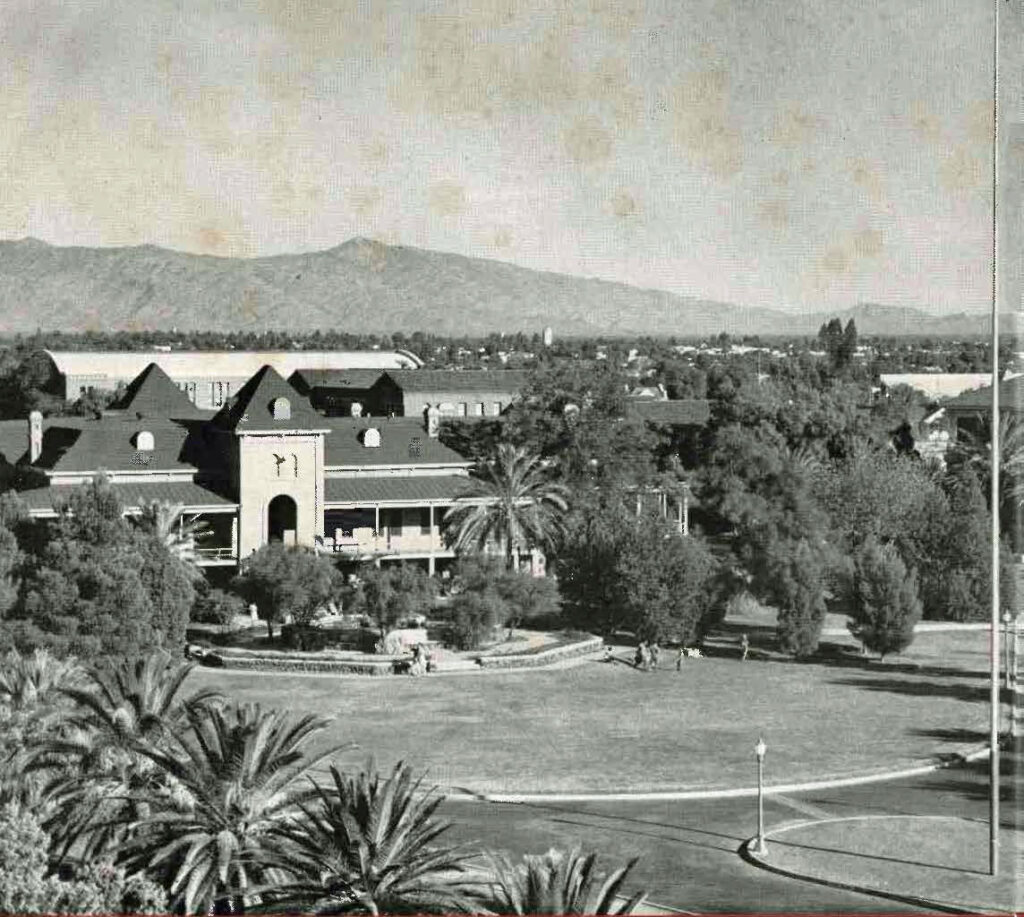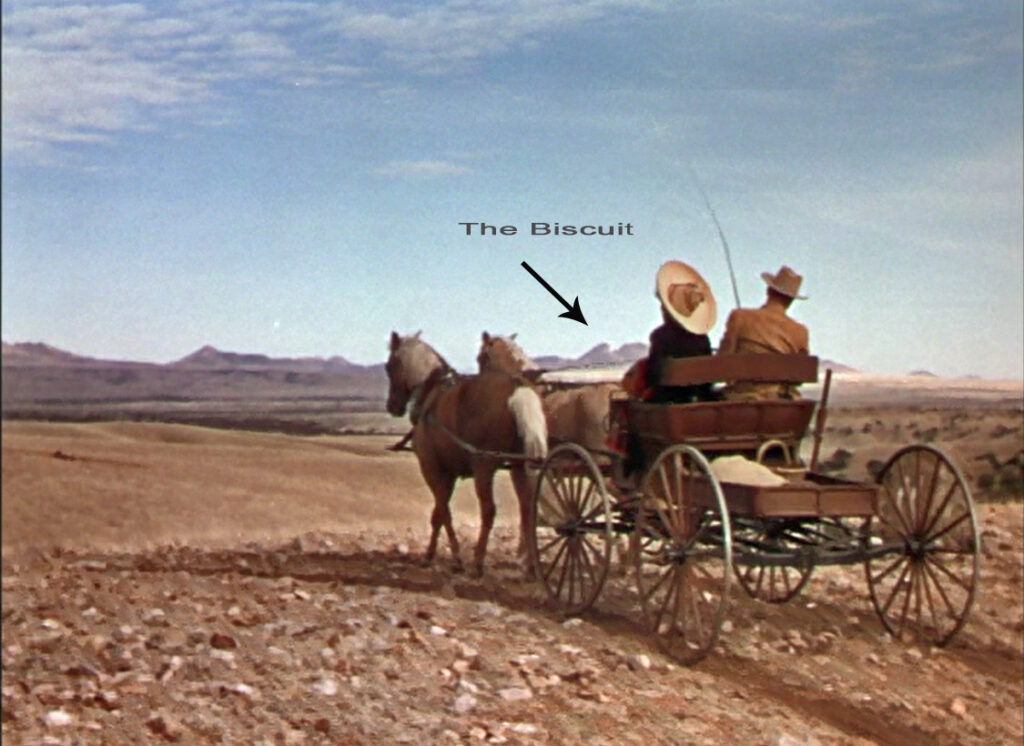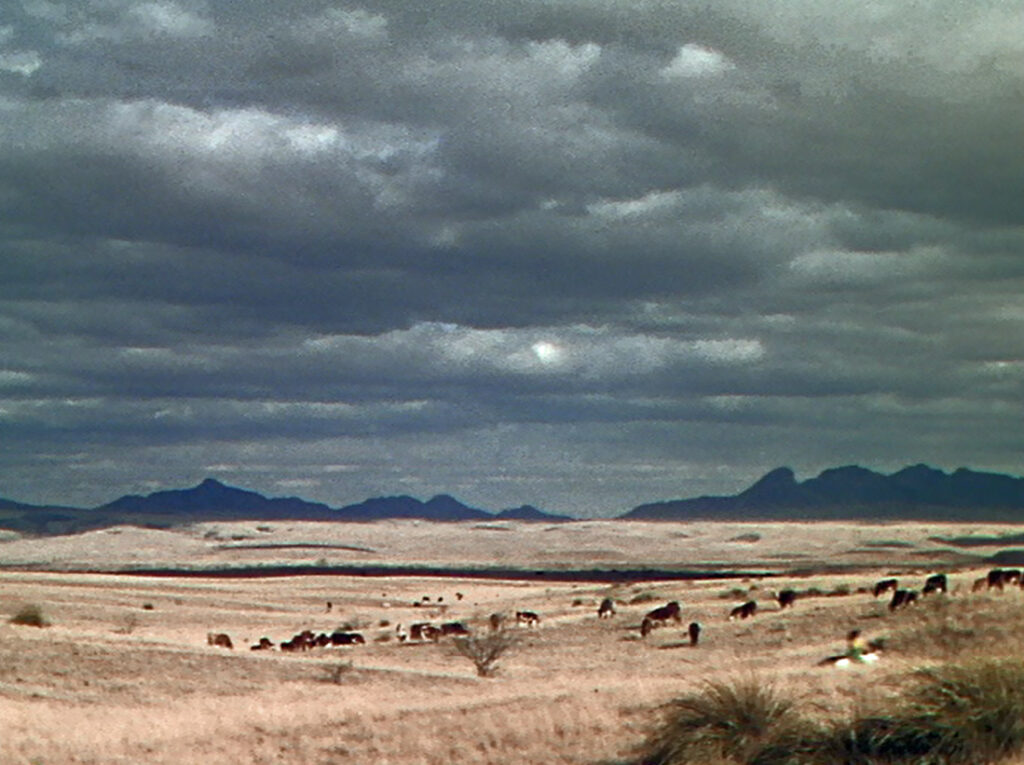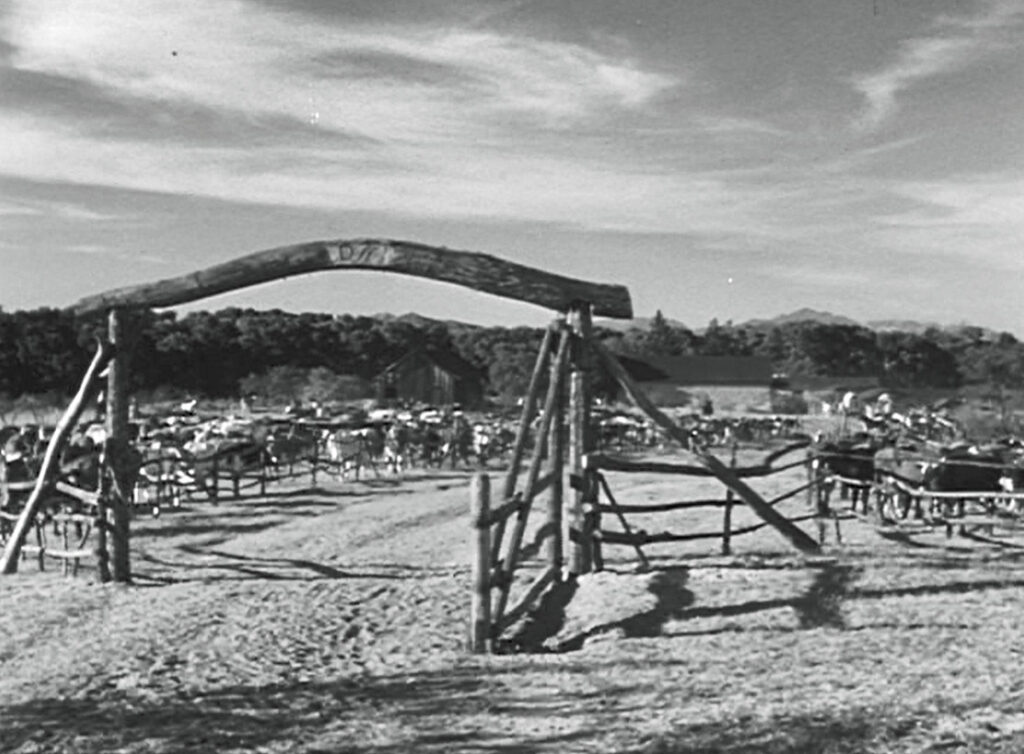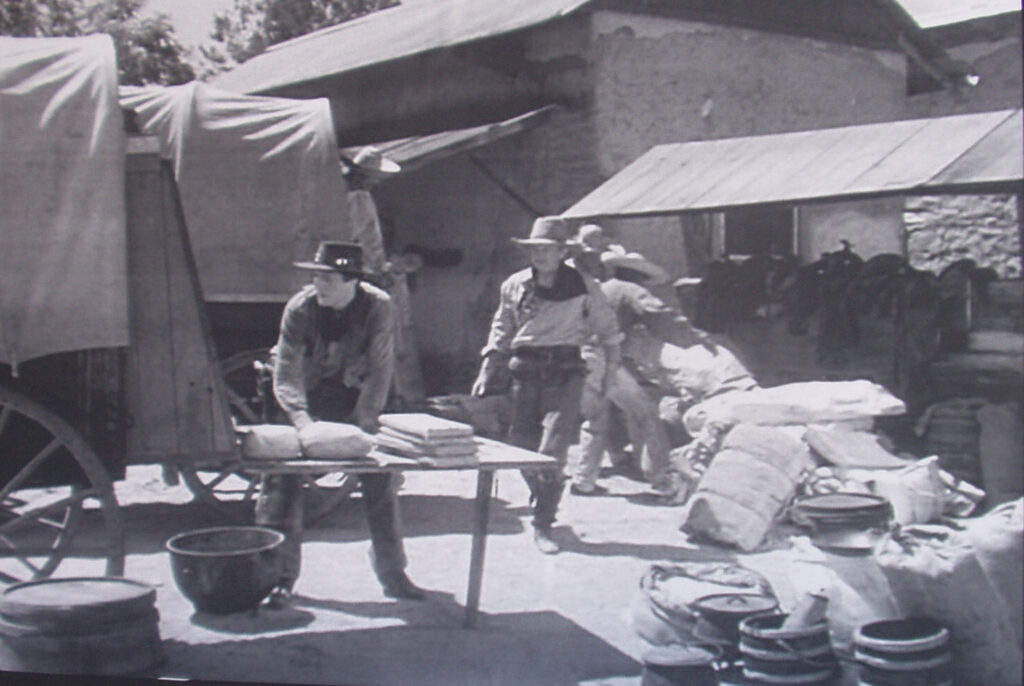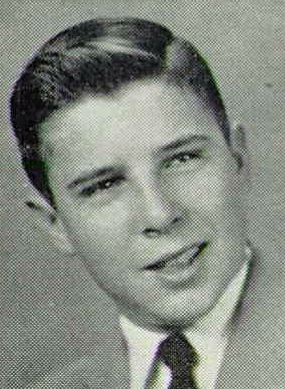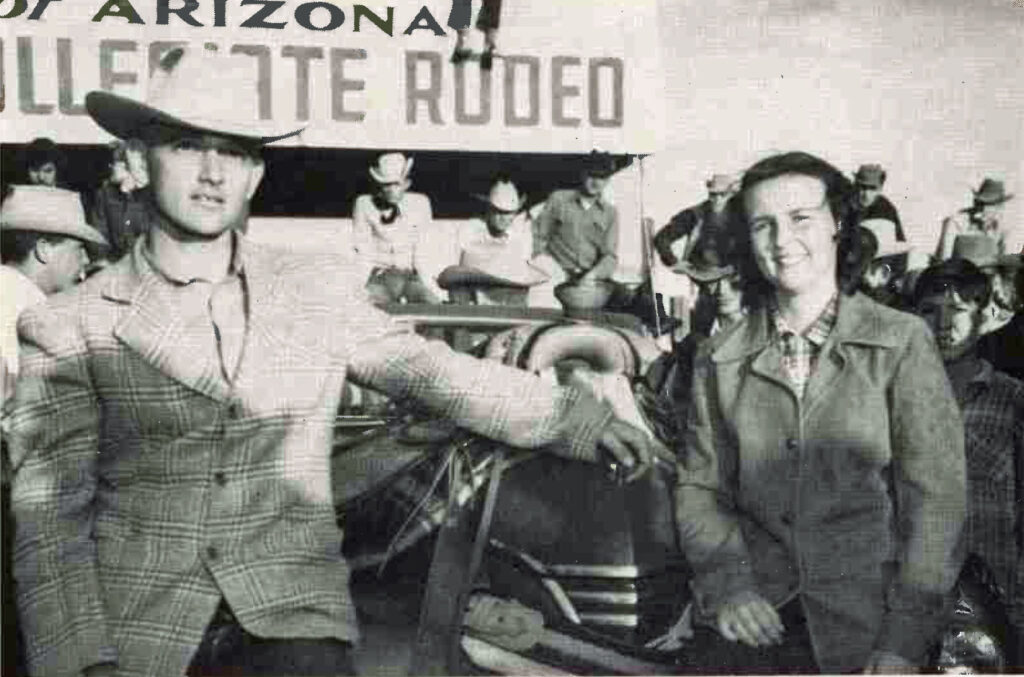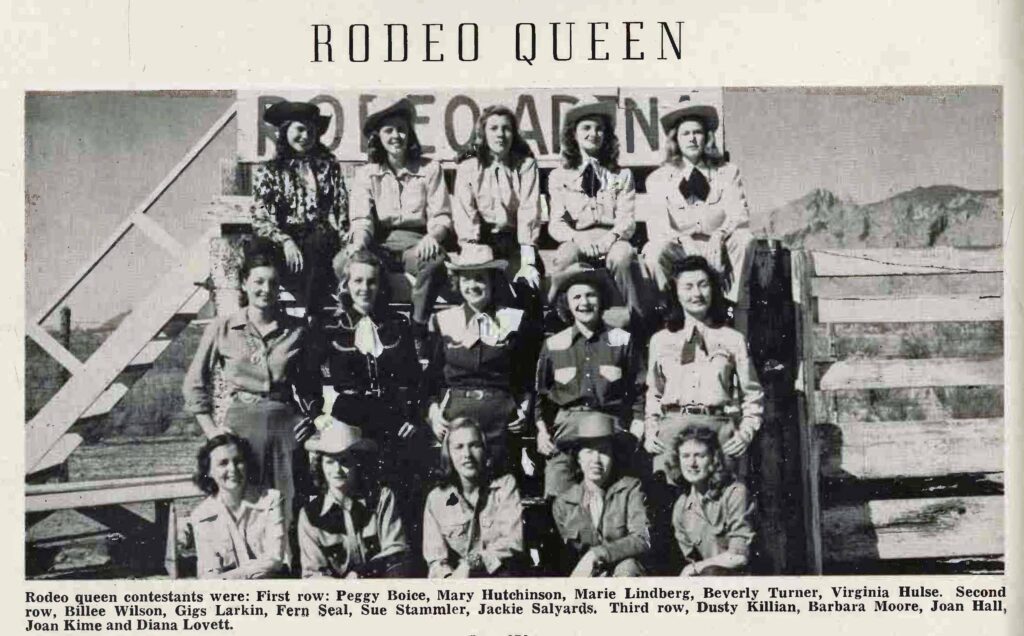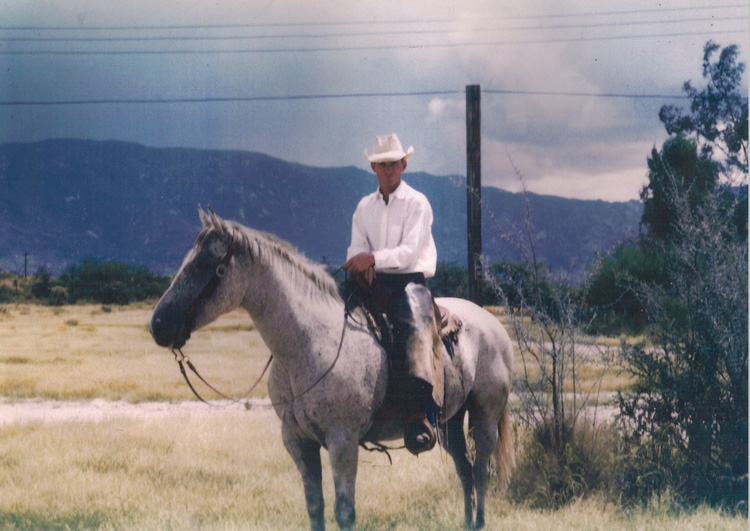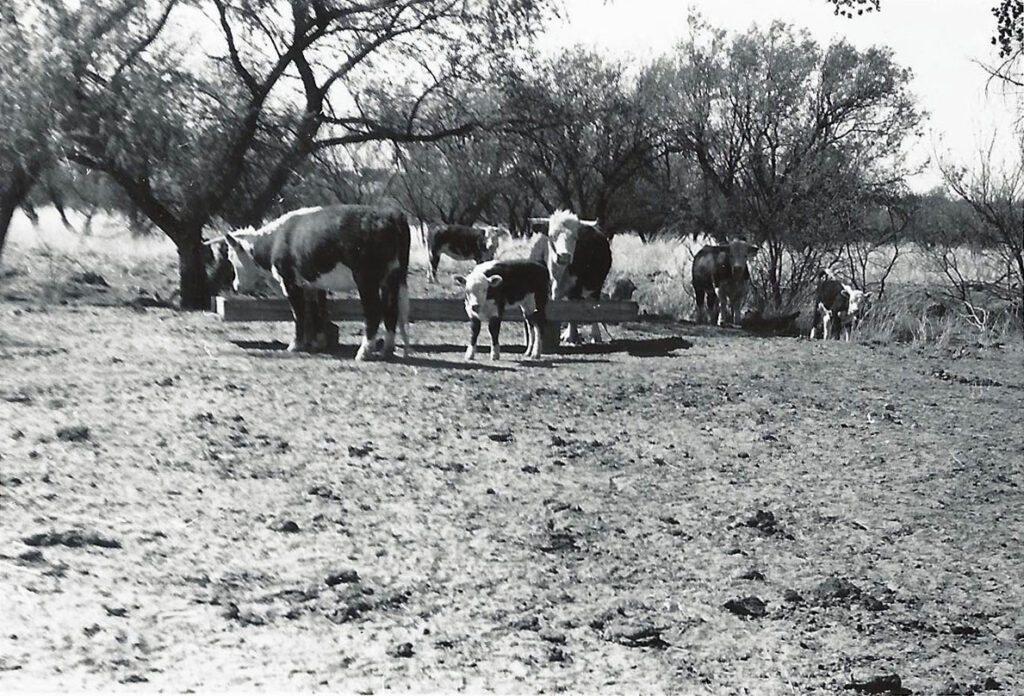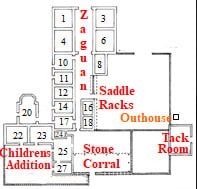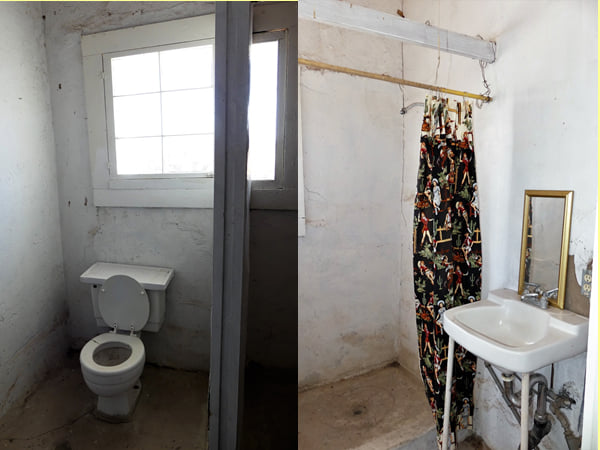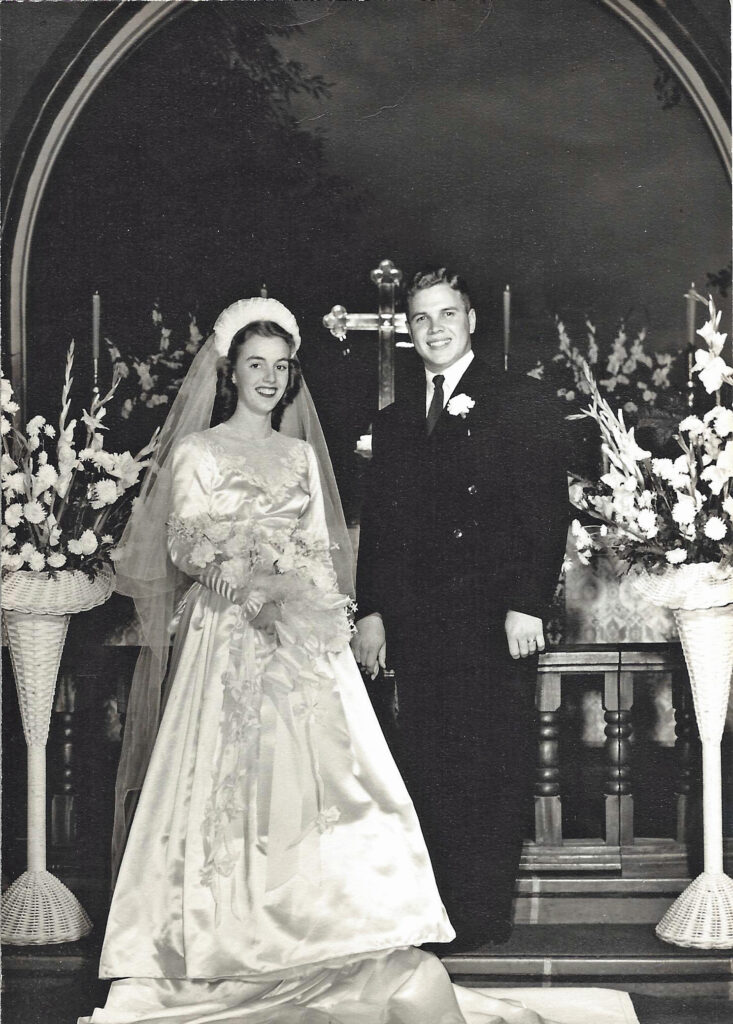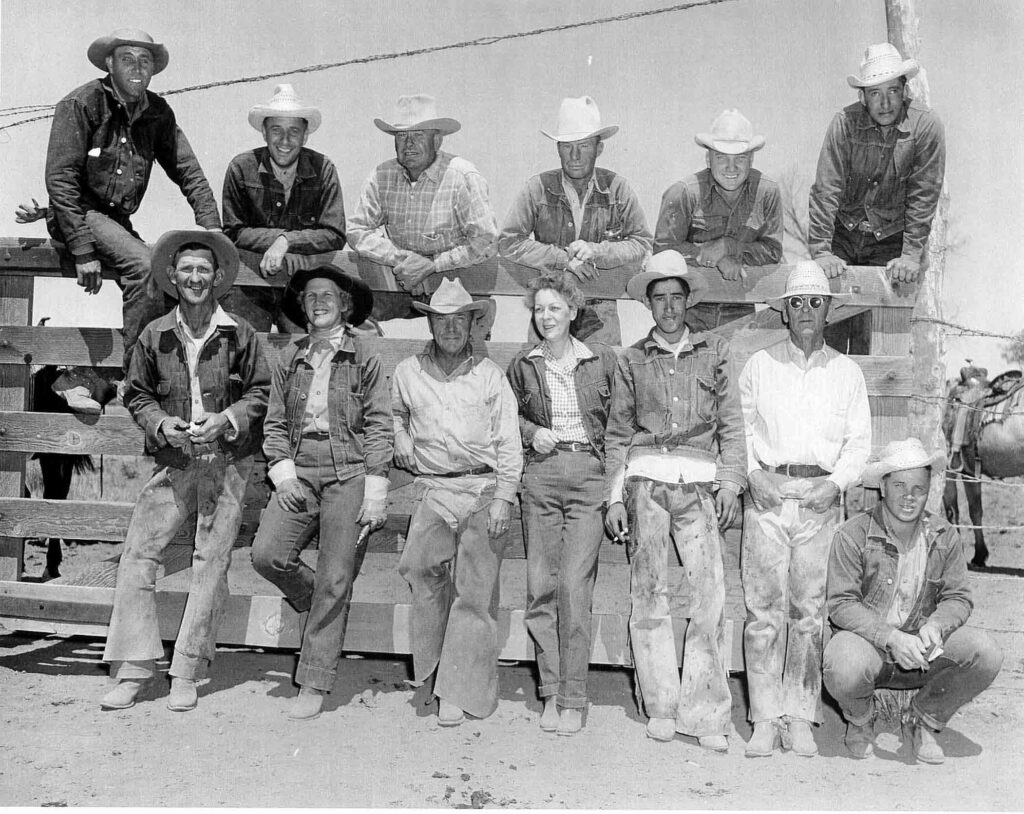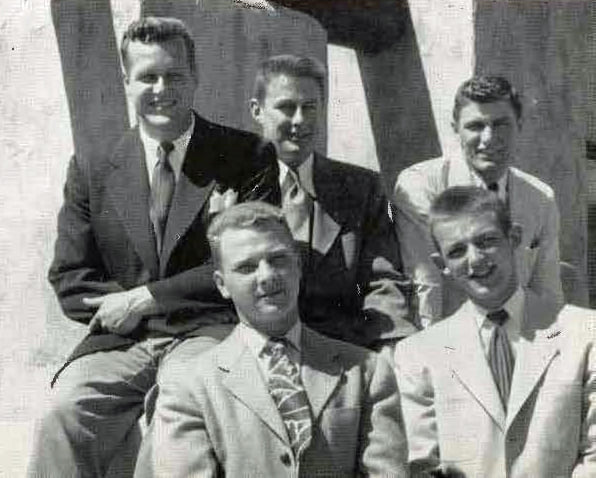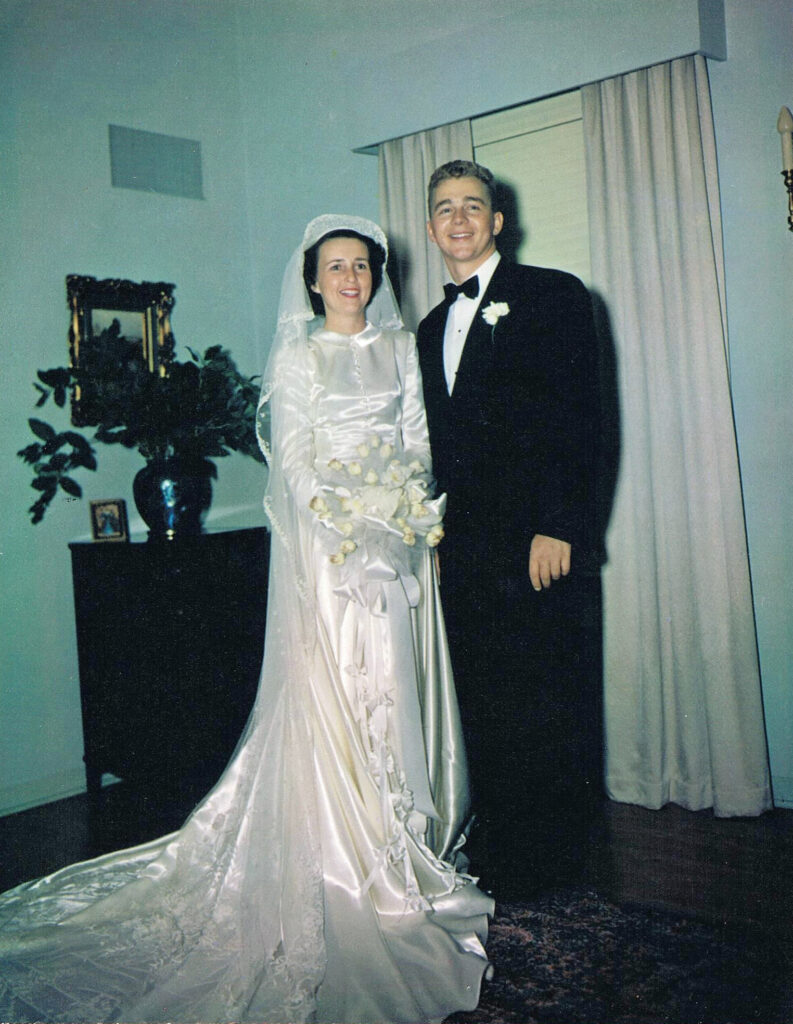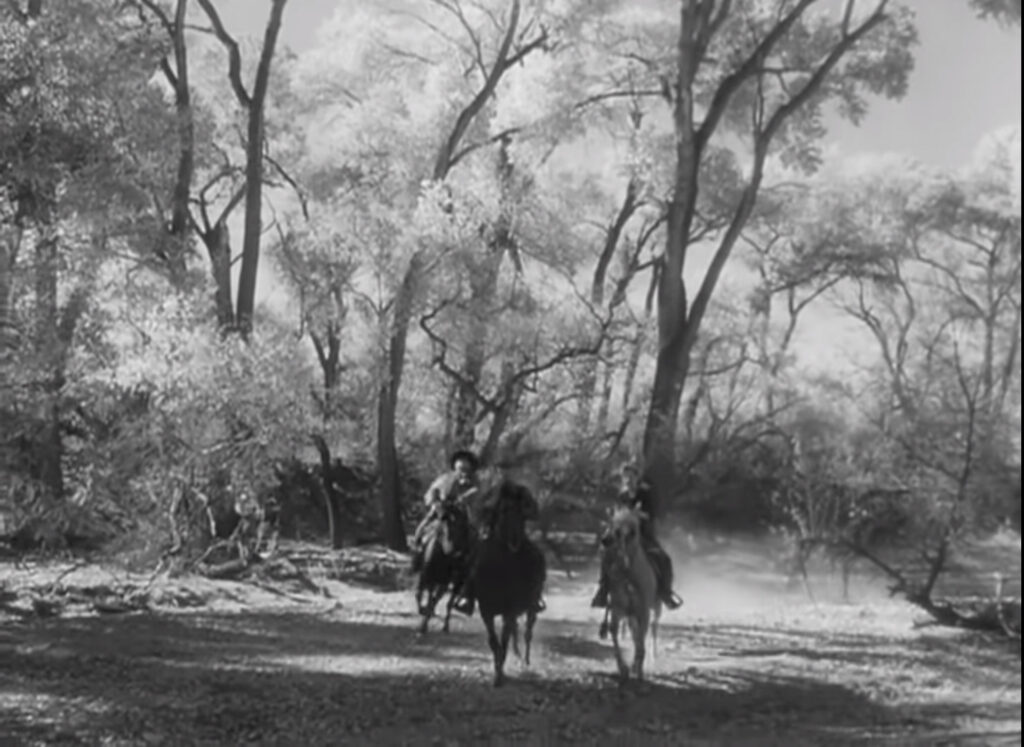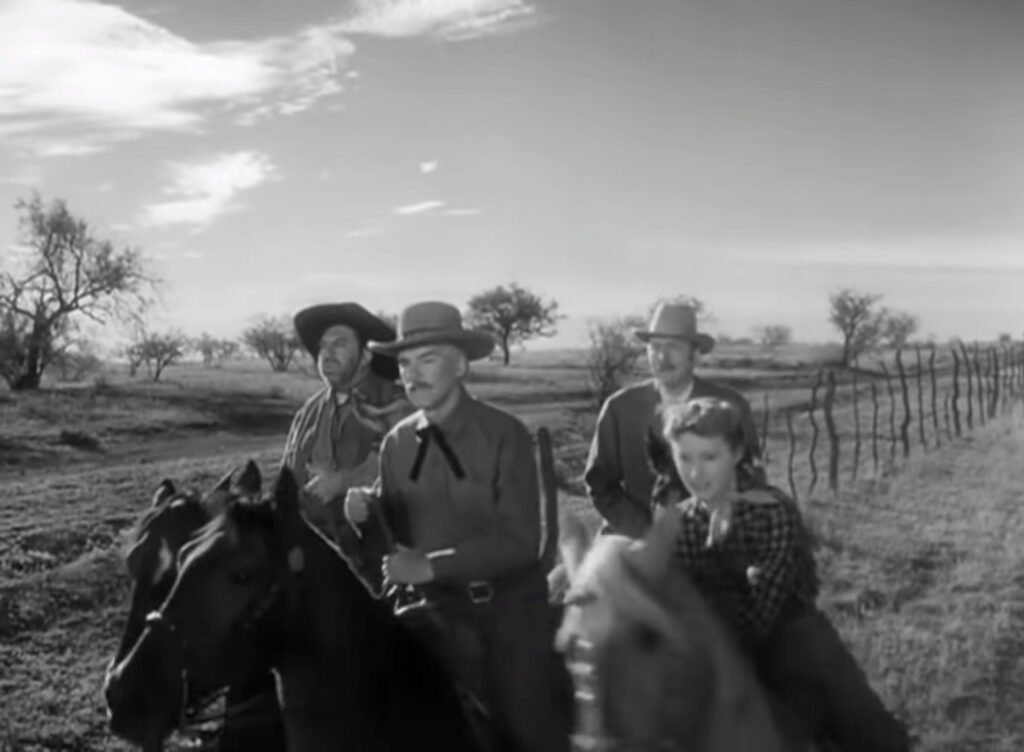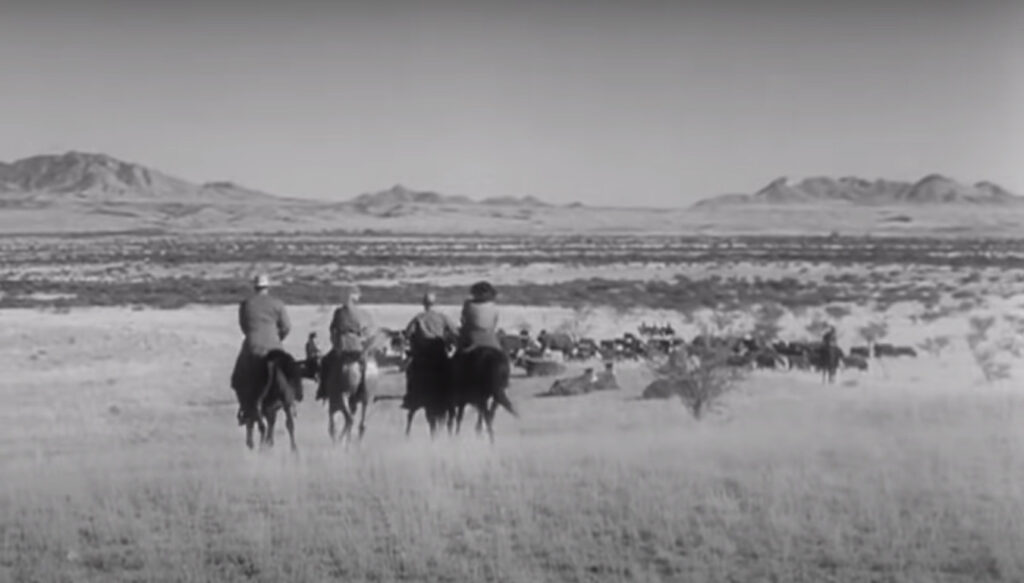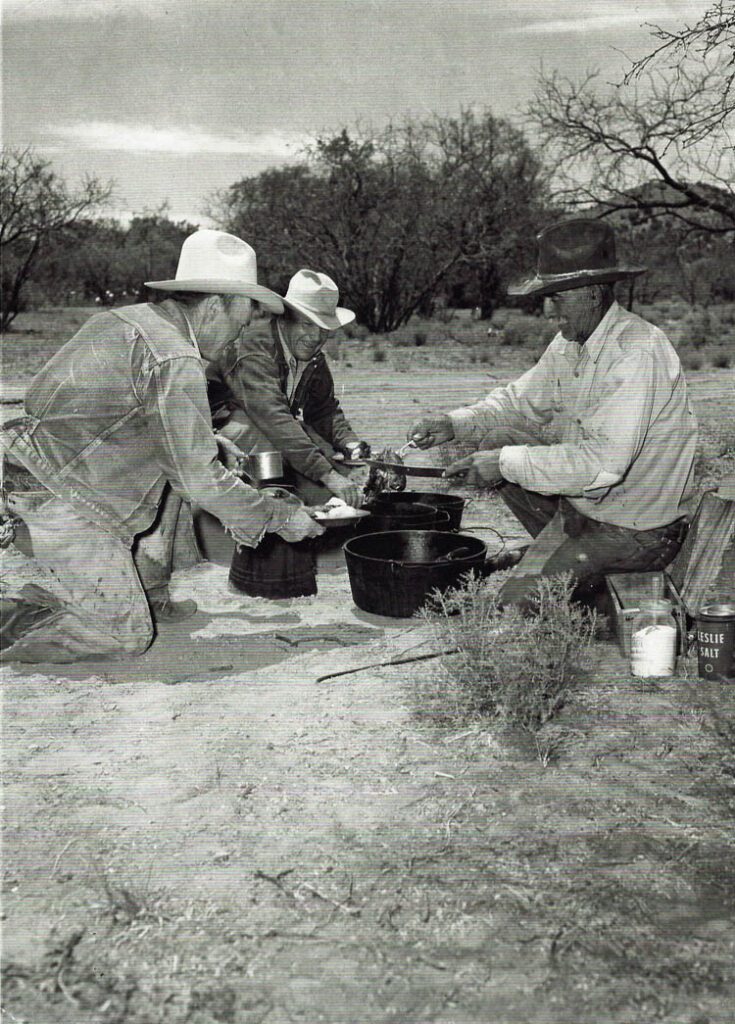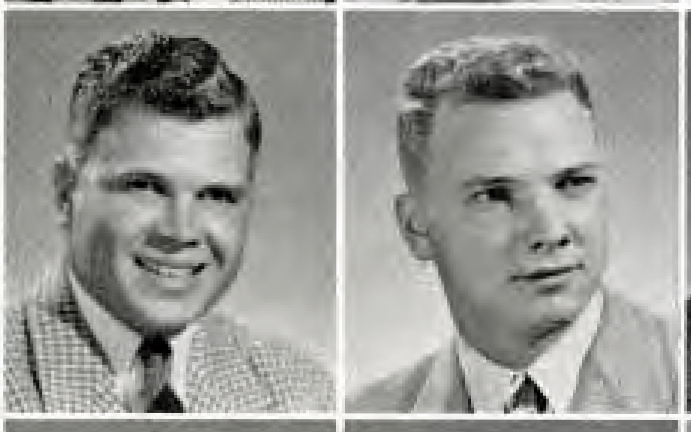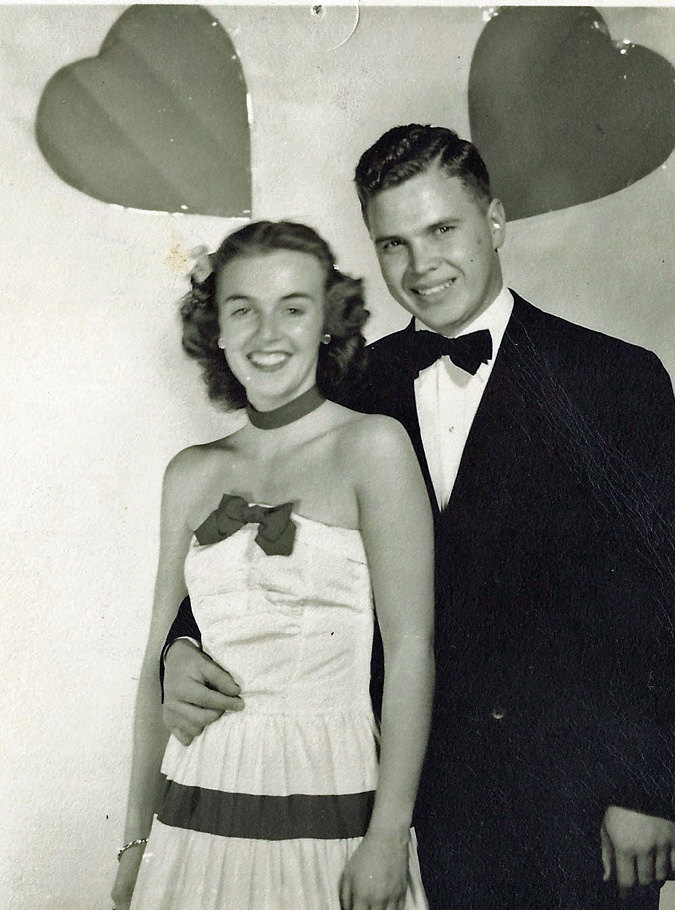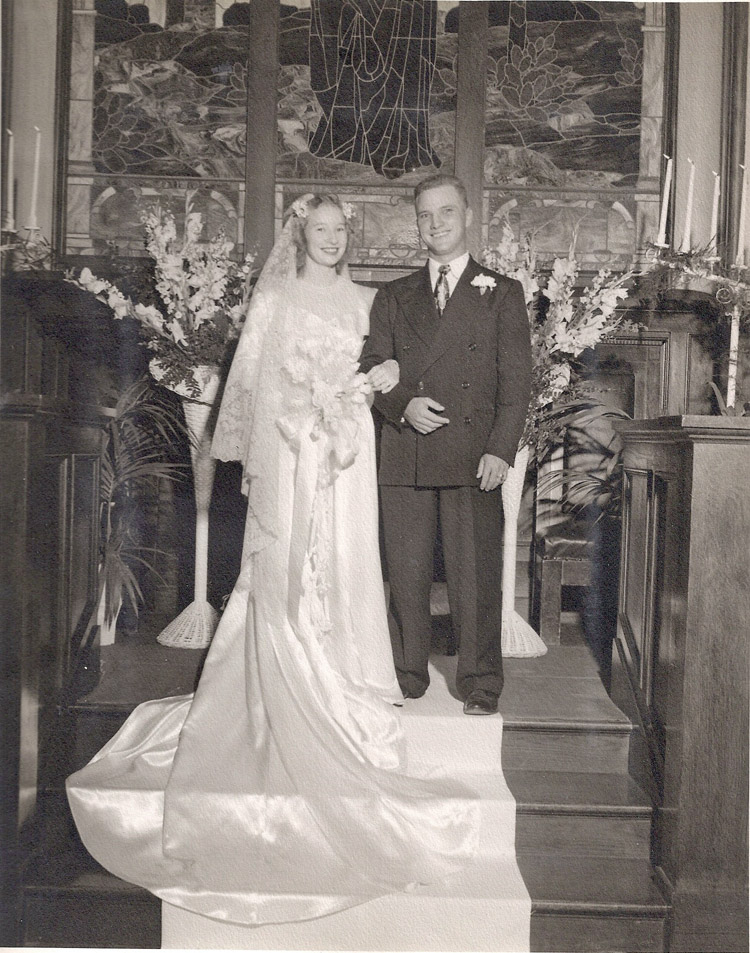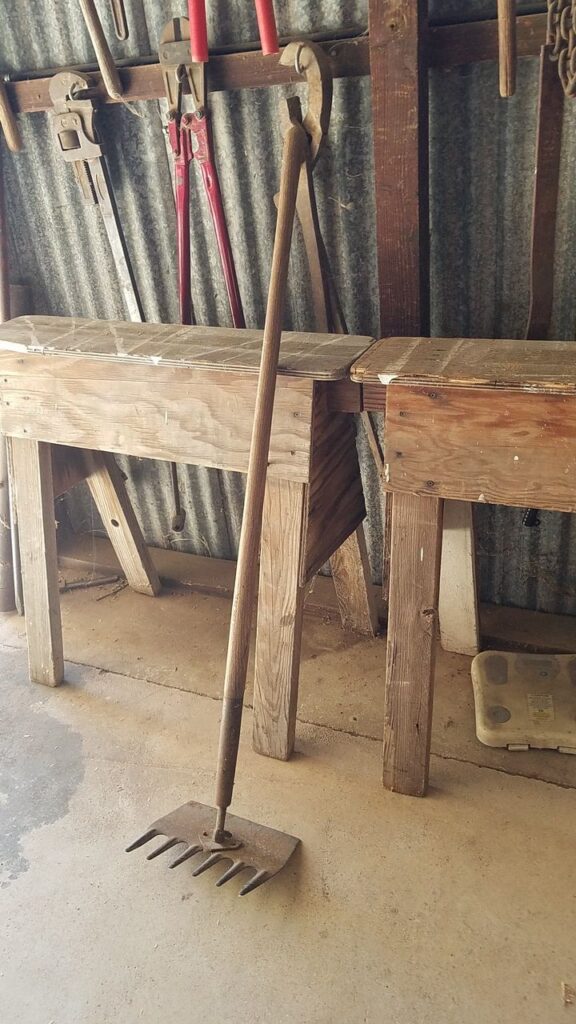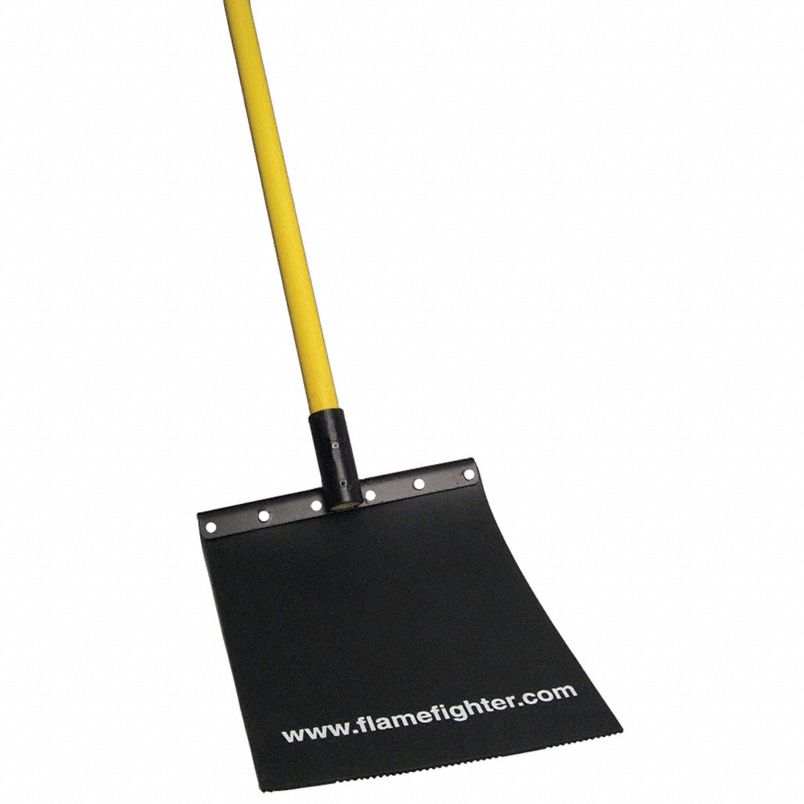Chiricahua Ranches Company Ownership, 1928-1951
Frank and Mary Boice Arrive at the Empire Ranch - 1929
Frank, Mary, Pancho and Bob Boice moved from the Onyx Ranch in Kern County, CA to the Empire Ranch. Mary Boice took photographs of their trip which included a stop for repairs of the starter on their auto.
Photos at left: Series of Mary Boice photos of the family’s move to the Empire Ranch, 1929. Courtesy of Martha Madani.
Charles Boice Marries Birdie Lucille Collings - 1929
Charles Boice married Birdie Lucille Collings in her hometown of Somervell, Texas on October 7, 1929. Miss Collings graduated from Texas Woman’s University in 1924. The couple made their home in Klondyke, Graham County, where Charles continued to manage the Eureka Ranch.
Sonoita Shipping Corrals - 1930
When the Boice Brothers began ranching at the Empire and Rail X ranches they were able to ship their cattle from Sonoita, using the shipping corrals were built in the mid-1920s. The New Mexico and Arizona Railway provide service to Fairbank, Sonoita, and Patagonia. Empire Ranch cowboys drove the cattle in droves down the dirt road that is now Highway 83. There were several hundred in each group that were taken to the Sonoita corrals. The Empire Ranch cattle could fill up dozens of train cars.
Arivaca Ranch Purchased - 1930
“Sale of the famous Arivaca ranch, comprising 300,000 acres, located in Pima and Santa Cruz counties, to Boice Brothers, well known Arizona ranch and stock owners, for a sum approximating $750,000 was announced yesterday by Ernest S. Wickersham of Safford, president of the Border Land and Cattle Company.” [Arizona Daily Star, 5/19/1930] “Cattle have been grazing the Arivaca ranges since long before the American Revolution.” [Richard Schaus, Hereford Tradition of Arizona’s Boices, 1959]
Charles Boice and his wife Birdie moved from the Eureka Ranch to manage the Arivaca Ranch.
Empire Ranch House Landscape - 1930
When Frank and Mary Boice arrived at the Empire Ranch they found that the vegetation surrounding the Ranch House was overgrown and somewhat neglected. The yard area on the west side of the Ranch House was enclosed with an ocotillo fence. Mary Boice was an avid gardener, and it would not take her long to bring order and beauty to the family landscape.
Henry Boice President ANLA - 1930-1933
Henry Boice was elected President of the American National Livestock Association (ANLA) in 1930. He served in this capacity until 1933. His presidential address in 1932, during the Great Depression, cautioned his fellow ranchers.
“In times like them it behooves all of us to stop and analyze the effects of present circumstances and changing conditions upon the character of each of us. There has been so much said about the need for assistance by the agricultural producers that there has unconsciously developed an idea that the agricultural producers are subjects for charity. There has been evident a feeling that this or that should be given to us free and it looks as though there is developing in the minds of some of the agricultural producers a ‘give me’ attitude which places them upon a charitable basis instead of a business. I am extremely anxious that the livestock producers do not develop this attitude. We are engaged in an essential and an honored business We are men who are accustomed to doing business on a business basis and paying for what we get. We cannot afford to deal with our government in a manner different from that in which we would deal with another businessman. We cannot expect our government to take money collected from taxes and donate it to us. Such dealings would weaken the character of each of us prevent us from looking the world in the face and unconsciously place us in the position of those who are not dealing or a business basis but who are asking for charity. I hope that we as livestock producers in the years to come can look the world squarely in the face with a consciousness that even though the depression left our business bent and sometimes broken our character is still untarnished.” [The Weekly Kansas City Star, 4/6/1932]
Mesquite Eradication - 1931
Shortly after arriving at the Empire Ranch Frank Boice recognized that the native grasses of the ranch lands were threatened by mesquite. In 1931 he collaborated with C. B. Brown, the county agriculture agent, and Dr. J. G. Brown of the University of Arizona to find a means to kill mesquite trunk stumps.
“Mr. Boice said the mesquite was so thick along the Cienega creek on the ranch that the cattle could not be found and driven out and he was forced to trim the mesquite. The experiments are being conducted on stumps freshly cut and two-year old stumps.” [Tucson Citizen, 4/3/1931]
Over the years Frank Boice would try differing methods of mesquite control, often in collaboration with UA scientists.
Report of the Rodeo (Roundup) - 1932
Eva Ferra, age 15, frequently wrote reports for the Empire [school] Merry Makers, which appeared in the Arizona Daily Star. Her account of an Empire Ranch rodeo [roundup] documents the complexity of rounding up cattle on a large ranch like the Empire.
“Mrs. Otis Christian and Eva E. Ferra drove up to the Hilton ranch where the cowpunchers had the rodeo, they took dinner to the cowpunchers. In the morning Mr. H.G. Bolce cut out the cattle he didn’t want. After dinner they branded one hundred and fifty-four calves. Eva enjoyed herself watching some of the boys flank calves and rope. Thursday, September 22, the round up and the camp moved down to the farm, it is about 9 miles from the ranch. On Monday, September 26, the roundup and the camp moved up to the Apache ranch. It is northeast up the Apache mountain from the farm. They will stay up at the Apache ranch about three or four days. The cowboys that work at the Empire Ranch at the roundup are as follows: Frank Scott, Amos Davis. Westley Grantham, Red Swanson, Buck Williams. Odeal Williams. Earl Adams, Arche King. Blas Lopez, Mae Spauder. George Morgan, Cole Power and Mr. and Mrs. Frank S. Bolce. From the Apache Ranch they Ewill move to the Williams Ranch over by Pantano, Arizona.” [Arizona Daily Star, 10/2/1932]
Margaret & Mary Members of the Elgin Book Circle - 1933
The Boice families quickly became involved in the Sonoita/Elgin/Patagonia communities. In 1933 Margaret and Mary Boice were members of the Elgin Book Circle, which began in 1922 when a group of 10 women living within a 50 miles radius of Elgin, organized to buy and share books, since they did not have access to a library. [Arizona Daily Star, 4/16/1933]
The membership of the Book Club was limited to 17 and each year 17 books were chosen to circulate among the members for a year. The Book Circle continues today.
Private Tutor for Pancho and Bob - 1934
“Miss Eleanor Struthers, has accepted a position as private instructor for the children of Mr. and Mrs. Frank Boice of the Empire ranch near Sonoita, Arizona, for the ensuing school year.” [Arizona Daily Star, 10/21/1934]
“For the first few years of their education the boys had a teacher living on the ranch. In 1936 they attended the Empire School (a one-room school from grades 1 to 8) that was located on the east side of the Santa Rita Mountains on Box Canyon Road. They went there for two years.” [Robert G. (Bob) Boice and Family by Miriam Boice, 2000]
Eva Ferra Helps Mary Boice - 1934
Eva Ferra, now 17, wrote: “Frank and Bobbie…, returned to the Empire ranch after staying two months in town. Since Mrs. Boice’s return to the ranch Eva Ferra will now resume her duties as general helper in the home. She has worked in this capacity for Mrs. Boice for more than two years and is glad to be back again. June 1 Mr. Frank Boice and Mrs. Henry Boice gave a surprise party for Mrs. F. S. Boice. They had a pretty big crowd, after supper they gave a dance. Everybody had a good time. [Arizona Daily Star, 6/10/1934]
Eva lived with her grandparents, Mariano and Juana Ferra, in the two room “Hired Man’s House” just north of the Empire Ranch House. Her grandfather first worked for the Vail family in the Rosemont area of the Empire, and in 1927 was assigned to work at the ranch headquarters. When the Boice’s purchased the Empire in 1929 they allowed Eva’s grandparents to remain in the adobe house. Eva helped Mary Boice with Bob and Pancho. She rode her horse, accompanied by her dog, Valente, to the Empire School located on Greaterville Road. The ride would take about 2 hours each way.
Frank Boice, President of Arizona Cattle Growers Association - 1935
In February 1935 Frank Boice was elected President of the Arizona Cattle Growers Association. Some of the major issues of concern to ACGA members that year included the proposed Taylor Grazing Act, extension by 14 months of the period cattle may be kept in Mexico to graze and give Arizona ranges a chance to recover, and support of state funding for the US Biological Survey for predatory animal and rodent control.
Tucson Livestock Show - 1935
In 1935 the first Tucson Livestock Show was held. Frank Boice was on the Board of Directors for the show. The show was held at the Tucson Rodeo Grounds in conjunction with La Fiesta de los Vaqueros, the rodeo parade, Indian day, and an Industrial fair. Each event was separate but held at the same dates and in the same location.
At the show the 10 best pens of 10 head of steers were selected to complete a 120-day feeding period at the University of Arizona experimental farm in Phoenix. “The results of the competition, a practical test in economy of grains, was the. magnet that drew the cattlemen from all over the state. The awards, announced by Dr. E. L. Scott, head of the beef cattle department of the university, were as follows: 1st Frank Boice, of the CCC ranch. 2nd Carlos Ronstadt of the 7X. 3rd Thompson brothers of Dos Cabezos. 4th Babbitt brothers of Flagstaff. 5th Heady and Ashburn, of Patagonia.” [Arizona Daily Star, 7/9/1935]
Mary Boice Landscaping at Empire Ranch - 1935
By the mid-1930s Mary Boice’s gardening efforts had transformed the family landscape on the west side of the Empire Ranch House. She created meandering paths and planted a cactus garden north of the Victorian Addition. The yard area south of the Victorian Addition featured a trellis, fountain, and lush flower beds with roses and irises.
The cactus garden is not evident by the 1950s. Perhaps the 5,000 ft. elevation of the Empire Ranch prevented the plants from thriving. The fountain is still present in the south yard, but no longer has a water supply.
Electrical Power at Empire Ranch - 1935
When the Boice family moved to the Empire Ranch they relied on generators for electricity. Use of generators would continue until 1957 when electrical power lines finally reached the ranch. A Koehler generator for the Ranch House was housed in a small shed in the northwest yard area.
Swimming Pool Added at Empire Ranch - 1935
A swimming pool was hand-dug sometime between 1935-1940. Its bottom had a shallow slope from west to east, and was six to eight feet deep at the east end where it drained. A small concrete-block shed at the southeast corner of the pool housed the filter machinery. The pool was drained every year and the walls re-plastered before it was re-filled with water.
Empire Ranch children and their neighbors all enjoyed the pool during the summer months. The pool was back-filled with dirt during the 1990s to mitigate safety concerns.
Jack & Gordon Cooper - 1936
Brothers Jack and Gordon Cooper worked a roundup at the Eureka Ranch in 1935 and in 1936 began to work at the Empire Ranch breaking horses. Jack Cooper described his work at the Empire: “Broke horses, went through the roundup. I never was a steady cowboy ‘cause I was in and out at the last on roundup so I figure I worked for about two and one-half years or three years with all my ends and outs. So I think he is greatest man, Frank Boice, one of the best men I ever worked for.” [Jack and Oliene Cooper oral history, 1991]
Jack also described the size of the crew and Mary Boice’s role: “They generally had about three or four steady riders up until roundup – during the spring and fall and then they had oh I’d say fifteen to twenty-one or twenty-two men. And then of course Mr. and Mrs. Boice was on the roundup. We did have Mary Boice and she was as good as two cowboys. She was a real rider I’ll tell you and she was a real mother to us cowboys. If we got hurt she was just like our my mother. She doctored us and tried to get us back on our feet like a cowboy would an old cow.” [Jack and Oliene Cooper oral history, 1991]
Screwworms - 1936
Doctoring cattle for screwworms was an important job for all cowboys. As Gordon Cooper recalled: “Sometimes we would rope… I have roped so much on a horse that by noontime he’d just had it. We’d rope sometimes 5 or 6 animals a day, but I’d have to change horses. [We used] that soot medicine (black).. [Gordon Cooper oral history, 1991]
A 1938 newspaper article noted: “The screwworm fly, which lays its eggs on wounds of livestock, is starting earlier than ever before and many more are expected as the weather grows warmer. The weather and other conditions – the deciding factor in any insect-pest outbreak – favor the rapid development of the screwworm in the southwest, as well as its spread to the north and northeast. The only practical way to protect livestock from screwworms, Dr. Pistor points out is to examine animals frequently so that wounds may be treated before becoming infested, or to doctor infested animals before the maggots have had time to cause serious injury.” [Casa Grande Dispatch, 7/15/1938] The “soot medicine” mentioned by Gordon Cooper was “Smear 62,” a black oily substance that was applied to the infected areas.
Forest Service Grazing Regulation Changes - 1936
In 1936 the Chiricahua Ranches Corporation (CRC) had permits to graze over 5,000 head of cattle on various allotments in the Crook and Coronado National Forest. That year the US Forest Service began to institute a new policy that would limit the number of cattle grazed on Forest Service allotments to 1,200 head. Since the four CRC ranches (Arivaca, Empire, Eureka, and Rail X) were considered one entity this regulatory change would have a drastic effect on their economic viability. The Empire Ranch leased over 44,000 acres in the Coronado National Forest, primarily in the Santa Rita Mountains.
One option the CRC partners considered was to break up the CRC and institute individual ownership of each of the four ranches. This option was not selected but the looming changes precipitated the eventual sale of some of CRC’s holdings.
Taylor Grazing Act - 1936
The Taylor Grazing Act of 1934 was finally enacted by Congress in 1936. The full title of the act defined its purpose: An Act to stop injury to the public grazing lands by preventing overgrazing and soil deterioration, to provide for their orderly use, improvement, and development, to stabilize the livestock industry dependent upon the public range, and for other purposes.
Western cattlemen were generally opposed to the act, as it placed over 80 million acres of public land into grazing districts to be administered by the Department of Interior. In his role as President of the Arizona Cattle Growers Association, Frank Boice expressed the concern of ACGA members: “…the plan could never work satisfactorily, and that it would cause friction among cattle raisers and sheep raisers. He expressed the opinion then that, once started, the government supervision plan would ‘be with us forever.’ The cattlemen contend that land under the jurisdiction of the erosion control administration can be cut off entirely from grazing use at the whim of the administration, and that privately-owned lands, such as exist in southern Arizona, bounded by state lands, public domain and forest service lands, are thrown under the same provision automatically, due to the fact that they are not of sufficient acreage to be of use without the lands they join. So the cattlemen resent the agreement to allot the rights of the state and of the cattlemen to the soil conservation bureau, and plan to fight such an allotment to the last ditch. [Arizona Daily Star, 3/13/1936]
A Dance for the Cowboys - 1936
“Mr. and Mrs. Henry Boice and Mr. and Mrs. Frank Boice entertained their cowboys and a group of friends at a moonlight dance given Thursday evening in the patio of the Empire ranch. Refreshments were served at a late hour.” [Arizona Daily Star, 6/10/1936]
It’s not clear where “the patio” of the Empire Ranch House was located. Possibly it was the area south of the Zaguan, just outside the “Cowboy Kitchen.”
Henry Dojaquez - 1936
Henry Dojaquez, the son of Mike Dojaquez and Felicita Escalante Dojaquez, worked at the Empire Ranch one spring in 1936. His father worked for the Vail family at the Empire Ranch in 1907 under the direction of Empire Ranch foreman Tom Turner.
Henry worked the Roundup and helped build a dam on the Cienega Creek, working with Charlie Grantham, Mary Boice’s brother. Frank S. Boice designed the dam and worked with them. The dam was washed out in a flood in 1938.
Rail X Ranch is Sold - 1936/1937
“Sale of a portion of the old Rail X ranch to the Crown C Cattle company, headed by C. Blake Carrington and C. L. Carrington. was announced yesterday. The consideration was in the neighborhood of $30,000. Some 4.700 acres of patented land and a national forest permit for grazing 250 head of cattle were in volved in the transaction. The sale was made by Roy Adams, who last December acquired the property from the Chiricahua Ranches company, headed by Henry, Frank and Charles Boice. The transaction completes the division of the old Rail X ranch. At the time Adams purchased the area in the northwest part of the ranch. David Jeffcott of Dragoon acquired another portion, while still another was sold to Rawson Harmon and Roland Keys. The Boice brothers retain their interest in the Empire, the Arivaca and the Eureka ranches.” [Arizona Daily Star, 3/30/1937]
After the Rail X sale Henry G. and his family moved to Tucson.
Arivaca Ranch - 1937
After moving to manage the Arivaca Ranch for the Chiricahua Ranches Company, Charles Boice and his wife Birdie had two daughters, LuBelle and Ann. Charles had several business interests besides ranching. In 1935 he obtained a liquor license for the Arivaca Mercantile Company. [Arizona Republic, 8/1/1935] He also operated an auto salesroom in Nogales.
Sadly, Birdie Boice died in April 1937. Birdie and Charles met in Pearce where she was teaching at Pearce High School and Charles was managing the Eureka Ranch for the CRC.
Women in Ranching - 1937
A newspaper article about the American National Livestock Association convention in Texas noted: “Mrs. Mary Boice, wife of Frank Boice, who is president of the Arizona Cattle Growers Association, and Miss Elizabeth Bixby of Long Beach, Calif., daughter of Fred Bixby, past president of the national organization, are other feminine delegates who don’t believe ranching is work for men only. Mrs. Boice, charming and gracious, rides range on her husband’s ranch. Miss Bixby is a fancy roper.” [Arizona Republic, 1/13/1937]
Pancho and Bob Boice’s Education - 1937
Starting in 1936 Pancho and Bob began to attend Pima County’s Empire School. “Bob didn’t like school very much and preferred to be with the cowboys. After a lecture on how dangerous snakes were he proceeded to tease the cowboys with a dead snake in his little red wagon. His favorite thing was to shadow the cowboy cook and his life’s ambition at that time was to become a ‘chuckwagon cook’.” [Robert G. (Bob) Boice and Family by Miriam Boice, 2000]
Both boys began riding at an early age and rode with their parents until they were old enough to participate in roundups on their own. Their cousins Peggy and Fred Boice also learned to ride as youngsters.
Frank Boice Reappointed to Farm Credit Administration - 1937
“Frank P. Boice, Sonoita, president of the Arizona Cattle Growers Association, yesterday was reappointed a director of the Farm Credit Administration of Berkeley by W. I. Myers, governor, Washington. His term runs until December 31, 1939.” [Arizona Republic, 1/17/1937]
Founded in 1933, the Farm Credit Administration is an independent federal agency whose function is to regulate the financial institutions that provide credit to farmers. Frank Boice was first appointed a director in 1933.
Eva Ferra and Richard Jimenez Marry - 1937
On November 25, 1937 Eva Ferra and Richard Jimenez married in the St. Rita in the Desert Catholic church in Vail. Dick had begun to work as a cowboy at the Empire Ranch in 1933. Eva grew up at the Empire Ranch and as a girl worked for Mary Boice. By the time she married Dick she was cooking for the cowboys and did laundry for them for a fee. Their daughter Mercy was born in 1938. In 1945 the family moved to the Crown C Ranch (formerly part of the Rail X) where Dick was the foreman.
Eureka Ranch Sold - 1938
In 1938 the Eureka Ranch was sold. The purebred Hereford bulls were moved to the Empire Ranch, and Fred Barnett, who had been managing the Eureka, became Empire Ranch foreman.
Fred and his wife Ruby lived in the Grove House, west of the Ranch House, and she cooked for the cowboys.
Ranching Today - 1938
An article entitled Horse and Lariat Still Hold Place on Range in the Arizona Daily Star featured photos and descriptions of the Empire Ranch roundups. “Mary Boice clad in Levis a broad brimmed felt hat and riding boots tests a shiny syringe and arranges packages of black leg serum where they will be handy when she wants them. A charming hostess and mother, she makes a hand on roundup.”
“Let’s watch Frank Boice. A short, stock, man with ready smile and twinkling eyes, he holds a college degree, has been an executive of the American Cattleman’s association and head of the Arizona Cattle Growers association. He has served on their directorates for many years. But he is no armchair cowman. With his rope shaken into a small loop, held close to his side, he rides into the herd on a blocky brown gelding wearing a VH brand.” [Arizona Daily Star, 12/25/1938]
Attending School in Tucson - 1938
“When Pancho was to start 7th grade the boys [Pancho and Bob] boarded with a Mrs. Frank on First Avenue in Tucson and attended Roskruge Elementary and Junior High. Bob continued to dislike school. He missed the ranch and his family but looked forward to their weekends at the ranch. The following year they boarded with Elizabeth McKinney, her son, Dan and daughter, JoAnn. Pancho attended Mansfeld Jr. High and Bob was enrolled in Sam Hughes Elementary School. Still trying to solve the problem the following year the family rented a house on 5th Street near Cherry Avenue and Mary moved to town with the boys.” [Robert G. (Bob) Boice and Family by Miriam Boice, 2000]
Living in Tucson during the week facilitated extracurricular activities, such as music lesson. “The students of Mrs. P.D. Coleman gave a piano recital and the Temple of Music and Art in Tucson. Frank (Pancho) Boice performed The Summer Sea by Ketterer.” [Tucson Daily Citizen, 5/27/1938]
Dee Edwards - 1940
Storeroom keeper Dee Edwards was 72 years old in 1940. He was fondly remembered by many at the Empire Ranch. “We had an old gentleman that was with Frank Boice’s father when he was… with the XIT. And so when he [Henry S. Boice] passed on, Frank and Henry took over Dee Edwards. And Dee Edwards took care of the commissary and the gas pump and swept the hall. And Dee was a character. He was a character. We all loved old Dee and paid no attention but he could sure tell you some rough old stories.” [Jack Cooper oral history, 1991]
“…he was an old retiree that came here with the people. He’s kind of a watchman/supervisor… And then he took care of anything in the commissary. If the cowboys needed tobacco or whatever, he wrote it all down. Whenever a cowboy from one of the camps, he wrote down everything that they took. They weren’t charged for food, but any tobacco or stuff extra.” “Old Dee Edwards used to get up and build the fire every morning before the cook got up.” [Boice Family oral history, 1991]
Frank Boice President of ANLA - 1940
Frank Boice was elected president of the American National Livestock Association in 1940. He served “with distinction during the hectic years when there was a strong fight to put the cattle industry under government controls, price supports and subsidies. His leadership is credited with keeping the industry on an even keel and free from government control. Being a tax expert, in the fullest meaning of the word, he organized the National Live Stock Tax Committee and served as its chairman until his death in 1956. This committee’s efforts are credited with having saved the nation’s cattle growers untold millions of dollars. It got the capital gains provision written into the tax law as its major accomplishment and also got established the constant unit value provision. These and many other tax matters the committee handled, with attorney Stephen Hart and Frank Boice doing most of the legwork in the labyrinthine jungle of Washington politics.” [Richard Schaus, Hereford Tradition of Arizona’s Boices, 1959]
A Home in Tucson - 1940
“When Pancho was to start high school they [Frank and Mary Boice] bought a house on Third Street and remained there until the boys graduated from Tucson High School. Still spending their weekends and summer vacations at the ranch.” [Robert G. (Bob) Boice and Family by Miriam Boice, 2000]
Ft. Huachuca “Land Grab” - 1941
“Proposed wholesale expropriation by the U. S. government, of valuable cattle raising land in Santa Cruz county, adjacent to Fort Huachuca. for military purposes was opposed last night at a meeting in Elgin, heart of the area, by ranchers and cattlemen. ‘It is our contention that beef is just as important as bombs to national defense,’ said Frank Brophy, well-known cattleman. Frank Boice, another cattleman urged the ranchers to send letters immediately to their representatives in Washington protesting the proposed swallowing up of rang land for military use.” [Tucson Daily Citizen, 9/25/1941]
Tucson Garden Club - 1941
With a residence in Tucson, Mary Boice was able to become an active member of the Tucson Garden Club. She combined her love of gardening and photography and began presenting slide shows at club meetings. “Mrs. Frank Boice will show colored slides of flowers and other flowering plants. Of special Interest will be the cactus flowers showing the flowers in detail.” [Arizona Daily Star, 4/13/1941]
“From 1935 to 1946 meetings [of the Tucson Garden Club] were held in the Fiesta Room of the Santa Rita Hotel on Scott Street. Methods of gardening in the desert area have always been a high priority, but during the WWII years the members became very involved in civic projects: bond drives, creating a Patriotic Garden at the Southern Pacific Railway Station and many others.’ [Tucson Garden Club website]
WWII Draft Concerns - 1942
On September 16, 1940, the United States instituted the Selective Training and Service Act of 1940, which required all men between the ages of 21 and 45 to register for the draft. By 1942 the draft was beginning to affect ranching operations throughout the west.
“Frank Boice, president of the American National Livestock association, said Tuesday as he left for Wyoming to confer with a selective service officials and draft board members there. Boice said cattlemen have been complaining that draft boards, in their patriotic zeal, have been depleting the range of cowboys In Wyoming, Montana and Colorado.” [Tucson Daily Citizen, 5/4/1942]
Wartime Beef Production - 1943
“Frank S. Boice of Sonoita, Ariz., association president, reported that United States cattle numbers are now close to the record figure of 76,000,000 head, an increase of 1,000,000 in the last year. Boice said the slaughter increased to 28,000,000 head in 1942. He predicted that marketings this year would surpass the 30,000,000-goal set by the secretary of agriculture. Boice cited these figures to prove that cattlemen are doing their best in wartime, but he forecast “dark days” ahead for the United States overall food production program because of what he said was failure of federal bureaucracies to coordinate their efforts. ‘Petty jealousies and inordinate ambitions are found in too many places,’ Boice declared. ‘The political partisan and social reformer are still at work and the old army game of buck passing is being played by experts.’ As a result of this agriculturalists are unable to obtain necessary labor, machinery, and supplies. Boice said the situation in Washington ‘calls for a reorganization which would combine responsibility and authority in the same hands with a boss at the top who has the authority and is tough enough to make these agencies work together, and who has a master plan to work with.’ Boice advocated immediate meat rationing, differing with most organized agriculture. Boice warned that parity should not be raised because he said such action would inevitably bring inflation and poverty to stock raisers.” [Arizona Republic, 1/16/1943]
In March 1943, meat and cheese began to be rationed. Frank Boice was appointed to the War Meat Board. He was most concerned that “Alternating gluts and famines In the beef market and further chaos in the meat industry will result from arbitrary government control and possible price ceilings on livestock” [Arizona Daily Star, 7/22/1943]
Mary Boice Wartime Activities - 1943
“Mrs. Frank Boice, Red Cross Grey Lady is pictured showing a convalescent man how to make ceramics in, the absence of Mrs. E. L. Ralston, who started this craft work at the base. Mrs. Boice’s “specialty,” according to the men, is showing them colored films of scenes in Arizona on her motion picture projection equipment. Grey Ladies like Mrs. Boice… are on duty at the base [Davis Monthan] three days a week now.” [Arizona Daily Star, 7/14/1943]
Mary remained active in the Tucson Garden Club where the programs began to focus on “Victory Gardens.” She was also admitted to the Tucson Woman’s Club and volunteered at the USO.
San-Pima Cattlemen’s Association - 1943
The San-Pima Cattlemen’s Association, consisting of cattlemen from Santa Cruz and Pima counties, met at the Santa Rita Hotel. Boice family members played key roles at this meeting.
“Frank Boice, president of the American National Livestock Association, will be the principal speaker on the program and is expected to bring before the cattlemen many of the new problems which face the cattle industry due to war time demands and curtailments. Henry Boice, who is chairman of a committee which has been checking on the availability of Mexican cowboys to help offset the labor shortage of Arizona ranches, will report to the association on the current status of the question. For the first time the association is inviting the junior cattlemen, sons and daughters of the members to the meeting, King said, and plans are being made to organize this group as junior unit of the parent association. Mrs. Mary Boice has headed a committee which has been making plans for this organization. King said.” [Arizona Daily Star, 3/16/1943]
Young Cattlegrowers of Southern Arizona - 1943
A new organization, the Junior Cattle men of South-Central Arizona was formed. “Ellis Mercer, of Sombrero Butte, was elected president, Frank Boice Jr., of Tucson, vice president, and Peggy Ann Boice, of Tucson, secretary and treasurer. Dan McKinney, Jr., was named historian. Mrs. Frank Boice and Carlos Ronstadt, of Tucson, were selected as sponsors of the junior organization.” [Arizona Daily Star, 3/21/1943].
Pancho Boice - 1944
Pancho’s senior year at Tucson High School was replete with accomplishments. He was on the football team, participated in track, and was President of the Senior Class. He was also elected master councillor of the DeMolays. After graduation he enlisted in the U.S. Navy where he attended electronics school and was stationed on a repair ship in the South Pacific.
Corporate Reorganization - 1944
On December 31, 1944 the Chiricahua Ranches Corporation was reformed as Chiricahua Ranches Limited Partnership. Henry G., Frank, and Charles were the three general partners. Fifteen individuals or trusts were general partners.
LuBelle Boice Dies - 1945
The family matriarch, LuBelle Boice, died on July 15, 1945 in Pasadena, CA. She was 73 years old. She was survived by her three sons, Henry G., Frank S. and Charles Boice, her two daughters, LuBelle Boice Young and Helen Boice Brennen, and 12 grandchildren.
Frank and Henry Buy Out Charles’ Interest - 1945
On December 31, 1945 the Chiricahua Limited Partnership was reorganized again with only two general partners, Henry G. and Frank Boice. Henry and Frank bought out Charles’ interest. Charles left ranching to pursue other business interests and eventually moved back to California.
Henry Boice began to manage the Arivaca Ranch in 1946, assisted by his wife Margaret, daughter Peggy (age 18) and son Fred (age 16). Fred had spent summers since age 11 working on the Arivaca for his uncle Charlie. The family had been living in Tucson in a house they built “in El Encanto when it was ‘in the middle of nowhere.’” Fred Boice recalled. They maintained their Tucson home as Peggy and Fred continued to attend Tucson schools. [Fred Boice, from Arivaca ranch hand to civic leader by Mary Peachin, 1962]
Bob Boice - 1946
Bob Boice graduated from Tucson High School in 1946. He ”became a better student but continued to dislike school and longed for life on the ranch. He too showed his leadership ability by being a class representative to the Student council his senior year.” [Robert G. (Bob) Boice and Family by Miriam Boice, 2000]
Bob played guard on the Tucson High School Badger’s football team, designated Tucson’s “most consistently winning team” that year. [Arizona Daily Star, 11/27/1945]. He was elected President of the Arizona Junior Cattlegrowers Association.
“Bob was registered for the draft, passed his physical and was deferred as long as he was in school.”
Peggy Ann Boice - 1946
Margaret Ann “Peggy” Boice was a leader in school and the community, and was active in Tucson social circles. She received the American Legion Award at Mansfeld Junior High School. At Tucson High School she was elected secretary-treasurer of Junior class and secretary of Senior class. She was a leader in the Arizona Junior Cattlegrowers Association, serving as secretary and vice president. For several years she participated as a “cigarette girl” at the Baile de los Flores fundraiser for St. Luke’s in the Desert Sanitorium. And she competed in riding at the Tucson Livestock Show and other venues on her horse “Taffy.”
Bob, Pancho, and Peggy Enter the University of Arizona - 1946
Pancho was discharged from the Navy and he and Bob entered the University of Arizona in the fall of 1946. They were in the same pledge class of Phi Gamma Delta fraternity. Peggy also enrolled at UA and pledged with the Kappa Alpha Theta sorority.
Hollywood Discovers the Empire Ranch - 1946
As World War II ended Hollywood began to film westerns on location in Southern Arizona. Duel in the Sun, starring Jennifer Jones, Joseph Cotten, and Gregory Peck, was partially filmed on the Empire Ranch in 1945; the film was released in 1946. The Empire Ranch scenes in the movie are outdoor ones, featuring the iconic “Biscuit” in the Mustang Mountains east of the Empire Ranch.
About 1946 the Boice family applied cement plaster to the adobe walls of the Empire Ranch House to protect and preserve the bricks. Bob Boice recalled: “I think it was between “Duel in the Sun” and “Red River” when it was plastered. They [film companies] were madder than hell that we covered up all the adobes.” [Boice Family Oral History, 1991]
Red River - 1946
In July 1946 the Arizona Daily Star wrote that “technical men” for Hollywood director Howard Hawks were visiting locations in Sonoita, Elgin and Fairbank to prepare for the filming of Red River. The Empire Ranch headquarters buildings were used in several scenes.
Bob Boice recalled: “…and they went down here in the cottonwoods and picked out a great big massive log, a perfect arch. They chiseled off one side, put that Red River “D” brand on it, and put it up on a couple of great big posts, and then had some little old flimsy salt cedar pole fences. Massive gate! That gate, actually we used it. It was a good gate, real heavy. Brand new lumber, and they got in there and just gouged it, made it look older than hell.” [Boice Family Oral History, 1991]
Gerald Korte - 1947
Gerald Korte was born in Tucson in 1929. He went to work for the Boice family at age seventeen and was a staff cowboy from 1946-1949.
Gerald described his work treating cattle for screwworms: “I’ve doctored fifteen in a day and had to rope an old cow or bull and lay ’er down and tie up their legs and doctor by myself – which I’ll tell you is a job. But I was pretty good – I could catch all the cows in with horns, and bulls too. And I could catch both horns and one front leg, and then you could pull ’em and lay ’em down. And then you’d have to jump off there and put your piggin’ string on the one front leg, and then pull in the two hind legs up and tied up, like you see ’em do these calves in a rodeo, except you’re doin’ it on a big ol’ cow or bull.” [Gerald Korte oral history, 2003]
Fred Boice - 1948
Fred Boice graduated from Tucson High School in 1948. Like his sister Peggy and cousins Pancho and Bob, he had a long list of accomplishments. He received the Eagle Scout award in 1944 and was the student body president at Mansfeld Jr. High School. He was vice president of Senior class, a member of the Badgers football, baseball, and tennis teams, and a sportswriter for the Tucson High newspaper.
Fred enrolled at his father’s alma mater, Occidental College, in Pasadena, CA.
University of Arizona Rodeo - 1948
In March 1948, the University of Arizona held its rodeo: “Go-western week for the more than 4,500 students and the additional faculty and staff members will start tomorrow, in preparation for the eighth annual Intercollegiate rodeo next Saturday and Sunday. In keeping with Go-western week, a corral was set up in front of Old Main yesterday and will open for business tomorrow. Tossed Into the corral will be those who fail to wear the traditional western garb.” [Arizona Daily Star, 3/7/1948]
Frank Boice provided the corral described above. Peggy Boice competed in the rodeo and won the Best All Around Cowgirl award after accumulating the most points in the event. She was also a Rodeo Queen contestant.
Foot and Mouth Disease - 1948
In 1947 the U.S. and Mexican governments worked together to control an outbreak of foot and mouth disease in Mexico. A quarantine line was established across the part of Mexico affected by the outbreak and U.S. personnel assisted with the vaccination of cattle to eradicate the disease. Austin Moss, a southern Arizona cowboy, described his work in remote areas of Jalisco. The vaccine had to be kept cold so they used popsicles “… to keep the vaccine cold. And then we’d go to the real remote areas where they didn’t have popsicles or anything like that …and they’d fly over and parachute us chunks of ice and we’d … put straw on them and what have you. And for most places we’d only have one or two drops to get 1500, 2000 head of cattle vaccinated. So we vaccinated them with 5cc under the skin. We had to rope them and we’d just dig six holes and put a snubbing pole, and then rope them and tie them up to that snubbing post and put a couple of Mexicans on their tail to hold them while we vaccinated them. And that’s how we started vaccinating. And then later on we showed them how to build chutes.” [Austin Moss oral history, 2007]
U.S. ranchers were seriously concerned about the possible migration of the disease to the U.S. “On the recommendation of the department of agriculture livestock advisory committee, national organization under the chairmanship of Frank S. Boice, Sonoita, Ariz., rancher, the department will launch a new research campaign against the foot and mouth disease. The committee labeled the cattle plague as ‘the foremost problem confronting the livestock industry in the United States,’ and asked that the current research and eradication campaigns be enlarged and intensified Into a comprehensive program.” [Arizona Republic, 12/19/1947]
More University of Arizona Collaboration - 1948
Frank and Henry Boice began collaborating with Prof. E. B. Stanley and Drs. O.L. Pahnish, W. L. Pistor, and Carl Roubicek, University of Arizona researchers, to develop a methodology for evaluating cows by recording birth dates and weights of the calves at the Empire and Arivaca ranches. “From this work an ‘index’ has been developed’ which shows the record of every cow and calf on a weight and grade basis. In selecting replacements, these index figures are used.” [Richard Schaus, Hereford Tradition of Arizona’s Boices, 1959] The data collection by the Boices lasted over a decade.
Bathrooms for the Cowboys - 1948
About 1948 two bathrooms, complete with showers, were installed in Rooms 6 and 8 of the Empire Ranch House for the use of cowboys and other staff. Prior to the installation the cowboys used a 3-hole outhouse located on the east side of the house corral, and a washroom, located in Room 16.
Pancho Boice and Sherry Bailey Marry - 1948
On December 27, 1948 Pancho Boice and Sherry Genevieve Bailey married at St. Philip’s in the Hills Episcopal Church in Tucson. Sherry was born in Chicago, IL on June 20, 1929. She was valedictorian of her senior class at Kalamazoo High School and entered the University of Arizona in 1946 where she and Pancho met. Sherry and Pancho returned to their classes at the University of Arizona after their marriage.
Empire Ranch Roundup - 1949
Despite leading busy lives in Tucson and at the University of Arizona an Empire Ranch roundup always brought the family together to get the job done. Participants in the 1949 Empire Ranch roundup are captured in this photo taken at the Empire Ranch corrals. Back row: (left to right) Manuel Sonohie, Bill Bailey, Paul Summers, Bob Haverty, Bob Boice and Bill Matus. Front row: Fred Barnett, Mary Boice, Frank Boice, Jo Bailey, Roberto (Junior) Rodriquez, Henry Boice and Frank (Pancho) Boice.
Bob Boice Wins Essay Contest - 1949
In his senior year at UA Bob Boice “won first prize in Arizona in a beef cattle essay contest sponsored by Swift and Company.” [Arizona Republic, 11/15/1949]
Bob was majoring in Animal Husbandry at the University of Arizona and was the house manager for the Phi Gamma Delta fraternity.
Peggy Boice Marries John Rubel - 1949
Margaret Ann “Peggy” Boice married John “Jack” Rubel in the Trinity Presbyterian Church in Tucson on November 9, 1949. Jack came to the University of Arizona in 1942 and graduated in 1948 after taking a few years off to serve in the Navy during WWII. Jack was from southern California and was a fullback on the UA football team.
After a honeymoon in Mexico the couple moved to California where Jack worked for the State Exploration Oil Company.
The Furies - 1949
The Furies, starring Barbara Stanwyck, Wendell Corey and Walter Huston, was filmed in several Tucson locations, including the Empire Ranch. “About 75 Tucson men and women were hired as extras during the company’s stay here. An equal number of construction workers were hired to help build three sets used.” [Tucson Citizen, 11/21/1949] The movie was released in 1950.
Corporate Changes and Land Sales - 1950
In May 1950 the Chiricahua Ranches Limited Partnership was reformed once more. Henry G. and Frank S. Boice were the general partners and Margaret T. and Mary G. Boice were the only limited partners.
“Another healthy chunk will soon be chopped out of the fabulous Empire ranch… Henry Boice, partner with his brother, Frank, in operating the remaining heartland of the ranch in the Sonoita foothills, yesterday confirmed reports that the northernmost 65 sections of the ranch will be sold to John Greenway.” [Arizona Daily Star, 12/1/1950]. The sale included the Rosemont Camp and the Cienega section of the Empire Ranch.
Bob Boice and Miriam Hamilton Marry - 1950
Bob Boice married Miriam Wilson Hamilton on September 7, 1950 in Trinity Presbyterian Church in Tucson. Miriam was born in Tucson 1928. She and Bob began dating in high school. Miriam and Peggy Boice Rubel were close friends, and Peggy was the matron of honor in the wedding. Miriam received her degree in Business and Public Administration from the University of Arizona and was a member of Kappa Alpha Theta sorority.
Bob and Miriam spent their honeymoon in northern Arizona and California. They made their home at the Empire Ranch where Bob assisted his father in the management of the ranch.
Grass Fire at the Empire Ranch - 1950
“A grass fire, fanned by a high wind, covered approximately 2,000 acres of grazing land on two ranches in the Sonoita-Patagonia area yesterday. Mrs. Frank Boice, wife of the owner of the Empire Ranch. reported that about 1,000 acres of grass was believed burned on the ranch owned by Gene Hummel and that a nearly equal amount was destroyed on the Empire range. Between 40 and 50 people made up the fire-fighting squad when the blaze was at its peak.” [Arizona Daily Star, 10/26/1950]
The firefighting “squad” probably involved Sam Fraizer who established the volunteer Sonoita-Elgin Emergency Services (SEESI) in 1946. “If Sam was called about a fire, the whole community would turn out. Ilene [Sam’s wife] says she sure learned how to use a wet gunny sack and a flapper, as did the whole community.” [http://sefd911.org/sam-frazier/]
Chiricahua Ranches Limited Partnership Dissolved - 1951
On December 31, 1951 the Chiricahua Ranches Limited Partnership was dissolved. Henry and Margaret Boice became the sole owners of the Arivaca Ranch and Frank and Mary Boice became the sole owners of the Empire Ranch using the corporate name of Empire Cattle Company.


